If you’ve been to Bangkok, Chiang Mai, Phuket or the beaches, yet haven’t visited the Kingdom’s northeast, you’ve missed Isaan: the heart of Thailand.
Our experience in Isaan was complimentary in conjunction with TBEX Asia 15, Thai Tourism Authority and the Association of Thai Travel Agents.
 Isaan (pronounced ee-SAHN, and also spelled Isan) is the northeast region of Thailand which shares a modern border with Laos and Cambodia. Isaan contains about one-third of Thailand’s total land mass and is home to about one-third of its people, too. But, Isaan isn’t as popular with tourists as Bangkok, Chiang Mai, or Phuket. This is precisely the reason we were so excited to visit Southern Isaan recently as guests of the Tourism Authority of Thailand. Our plan was to experience the cultural spirit, discover exquisite products made by traditional artisans and craftsmen, and partake of the outstanding cuisine which makes Isaan the heart of Thailand. If you wish to make your experience there more convenient, it would be a great idea to learn thai.
Isaan (pronounced ee-SAHN, and also spelled Isan) is the northeast region of Thailand which shares a modern border with Laos and Cambodia. Isaan contains about one-third of Thailand’s total land mass and is home to about one-third of its people, too. But, Isaan isn’t as popular with tourists as Bangkok, Chiang Mai, or Phuket. This is precisely the reason we were so excited to visit Southern Isaan recently as guests of the Tourism Authority of Thailand. Our plan was to experience the cultural spirit, discover exquisite products made by traditional artisans and craftsmen, and partake of the outstanding cuisine which makes Isaan the heart of Thailand. If you wish to make your experience there more convenient, it would be a great idea to learn thai.
The traditions of Isaan are rooted in the Khmer Boran (“ancient Khmer”) aspects of the Chinese Chenla Kingdom (550-706) and the Khmer Empire which held power between the 9th and 15th centuries.
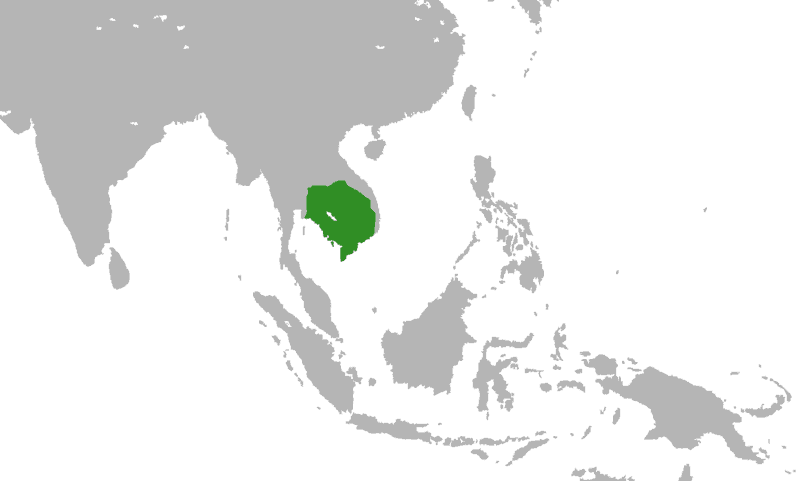
Chen-La feudal area
Chenla was a Chinese feudal system as part of which indigenous tribes and groups from Southeast Asia sent payments north to its emperors in exchange for protection. The Khmer Empire which followed was an amalgamation of Buddhist and Hindu elements. Its hierarchy contained different societal classes of craftsmen, artisans, religious leaders, commoners and royal elite.
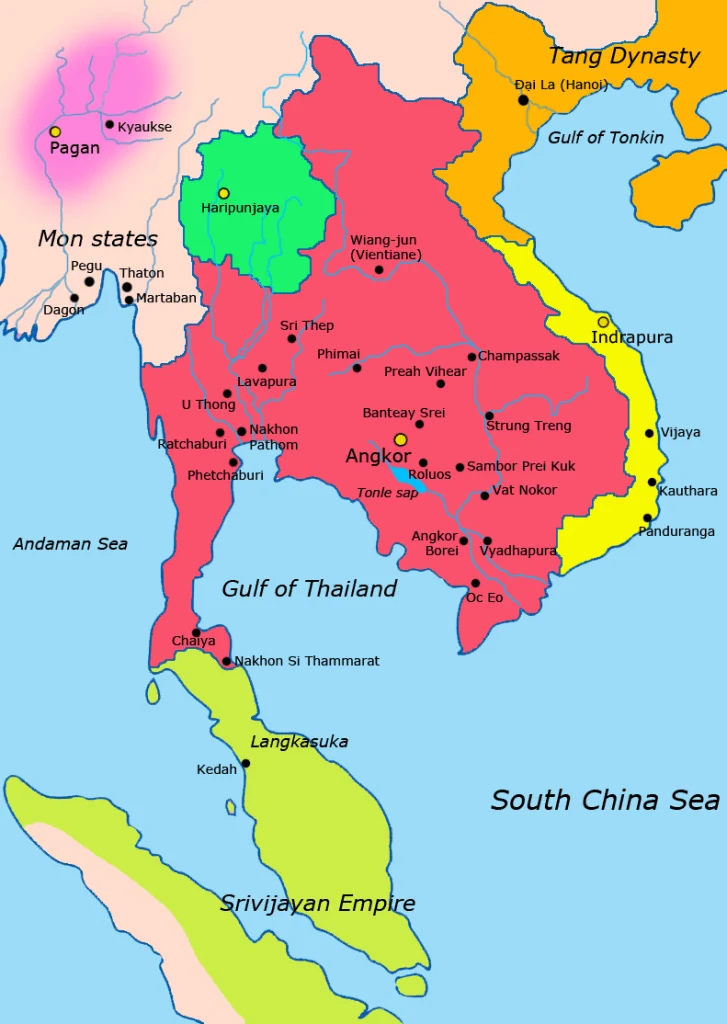
Map of Southeast Asia in about 900. Khmer Empire is shown in red.
The Khmer’s most well-known historical remnant is the enormous network of sandstone temples scattered throughout this part of Thailand, Laos and Cambodia. Isaan’s temples are generally about 100 years older than the more famous Angkor Wat in Cambodia, about 20km from the border.
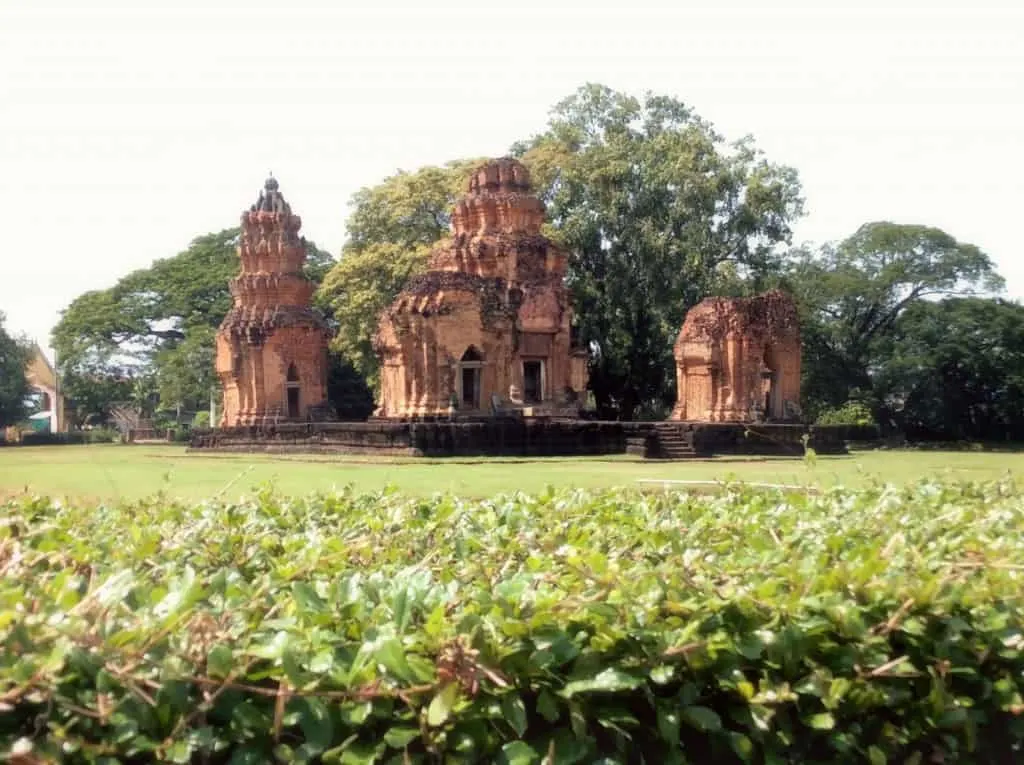
Prasat Sikhoraphum dates from the 12th century. Converted to Buddhist temple in the 16th century
The decline of the Khmer Empire is somewhat of a mystery. Satellite imagery suggests an environmental collapse due to the inability to effectively manage fluctuating water supply. In a primarily agrarian region, this would have spelled disaster. Other sources point to political and economic failure, but since the region is still so agriculturally dependent we think it fair to say alternating drought and monsoon conditions hastened its downfall.
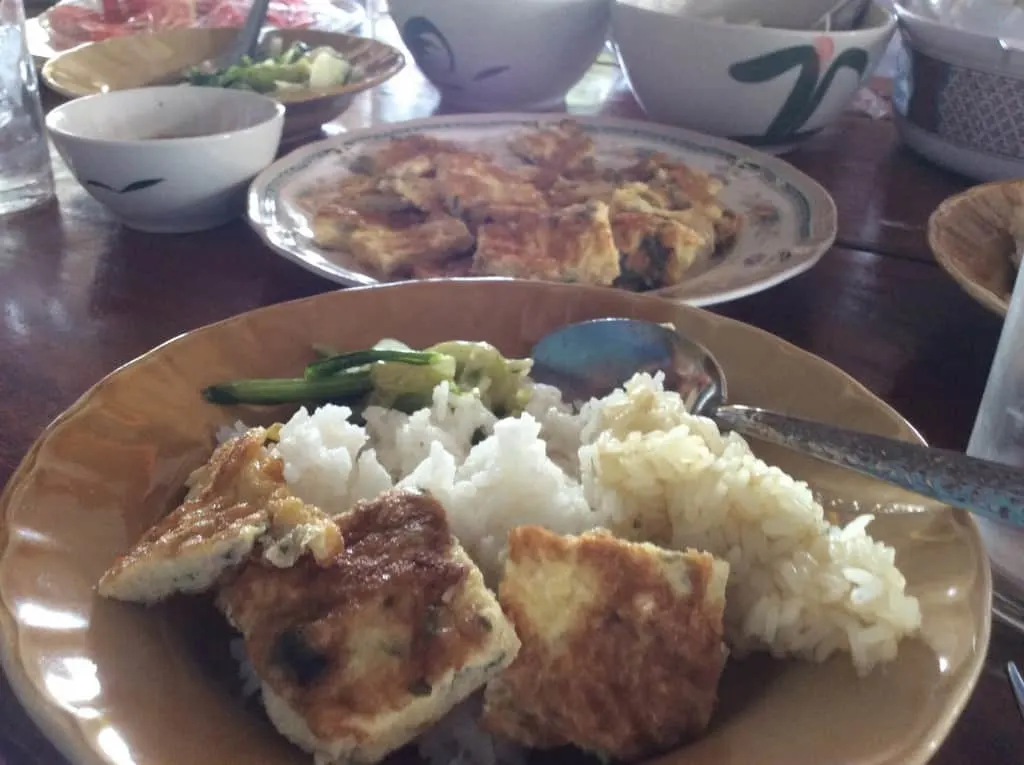
Traditional cuisine served with jasmine rice at Ban Arlue, an ethnic Kui village
In modern times, the canal and reservoir system has been resurrected and improved, restoring Isaan as the “rice basket” of Thailand. Farms still group around cities and villages in Isaan today in a paddy network which produces the coveted Jasmine rice. Other crops are sugarcane, cassava, fruit, coconuts, other vegetables and sugar palms. The local cuisine offers up fresh water fish and prawns in abundance, with pork, beef and fowl rounding out the menu.
- Dipping shellsi and fish at Celebrate Restaurant in Surin
- Fish dish at Celebrate Restaurant in Surin
Khmer dialects are still widely spoken in Isaan’s Surin and Buriram provinces where we visited. Ethno-linguistically, the people identify more Lao, and their physical characteristics often display a distinctly “Lao-like” facial structure and body type.
– – –
Slowly, our group filed into the large main room of the empty restaurant in Surin. All the other patrons were out in the front beer garden. A yellow-shirted line of boy musicians seated cross-legged on the dais strummed strange looking stringed instruments, blew into bamboo flutes, shook tambourines and beat bongo-like drums. The music was loud and grating to western ears.
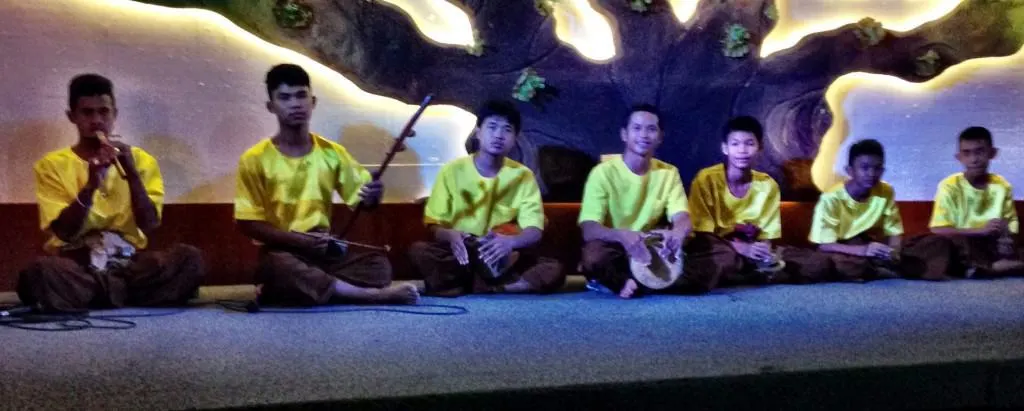
Abandoning small talk for want of hearing ourselves at the table, which had been carefully and luxuriously set with satin brocades, we felt self-conscious. What looked like a Christmas tree made from banana leaves with chrysanthemums and lengths of yarn for ornaments was in front of us. The dimly lit discord was perhaps the most bizarre atmosphere we’d encountered in over a year of full-time travel all over the world.
We were in for a treat, smiled our guide. Miss Nam Pheung Muang Surin and her traditional dancers would perform a special Bai Sri Su Kwan welcome ceremony for us. “Anything,” I thought, “to stop the clanging and twanging of the band.” It wasn’t even close to my idea of melodic. Our day had begun at 4am in Bangkok and we were tired and hungry.
Then, in glided Miss Nam, petite in a bouffant, ornamented hairdo, traditional silver jewelry, and vivid jacket with elephant-patterned scarf. Closing her eyes and clasping hands as if in prayer in front of the banana leaf tree, she began to chant.
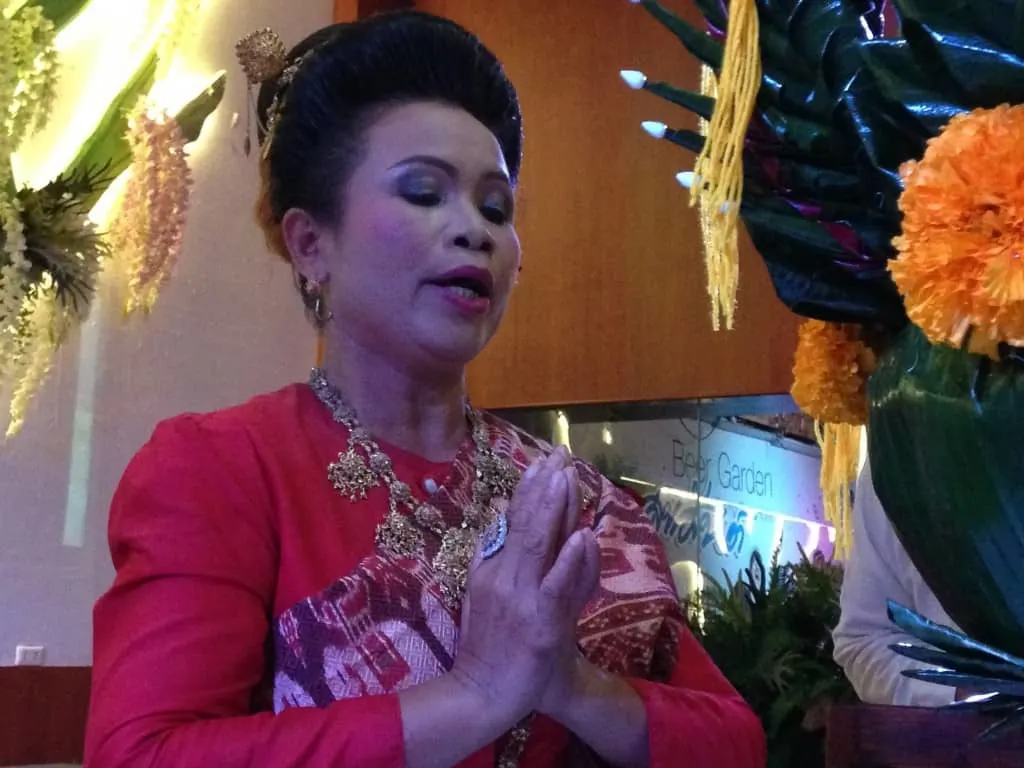
Fervently and reverently, her song lifted in stairways of notes, and tumbled in cascades of sound. Mesmerized by the rhythmic instruments and intonations, I hardly noticed that her dance troupe had approached the table and begun to tie the yellow yarn into bracelets on our wrists. The Bai Sri Su Kwan ceremony encourages the Kwan protective spirit that each of us has to remain with us. During the tying, the spirit is asked to banish negativity and allow good to remain. Guests are thus honored into the communal fold. The music hadn’t changed throughout all this, but a transformation had taken place. I was mesmerized and relaxed. Was my Kwan really present?
We finished our dinner to the accompaniment of gentle singing and graceful dancing, bathed in this traditional welcome from Isaan, the heart of Thailand.
Note: A more typical itinerary in Thailand will include visits to Bangkok or islands in the south. One of the most popular is Phuket, which is known for its party scene. But there are different ways to experience the culture up close and personal. For example, check out this elaborate article on bikes for rent in Phuket. We can recommend the Ramada Phuket Divana (see our review here) as a quieter place to stay away from the main party areas.
———
Over the next two days, we visited several different villages renowned for Isaan craftmanship. Silk has been cultivated, dyed and woven in complex patterns supplemented with threads of gold and silver here for centuries. In the Queen Sirikit Sericulture Center, we observed the entire silk-making process from silkworm larva to spun dyed hanks of thread.
- Silkworms are fed mulberry leaves
- Hanks of raw silk are hung to dry
- Thread is boiled to soften
- Thread is spun into fine widths
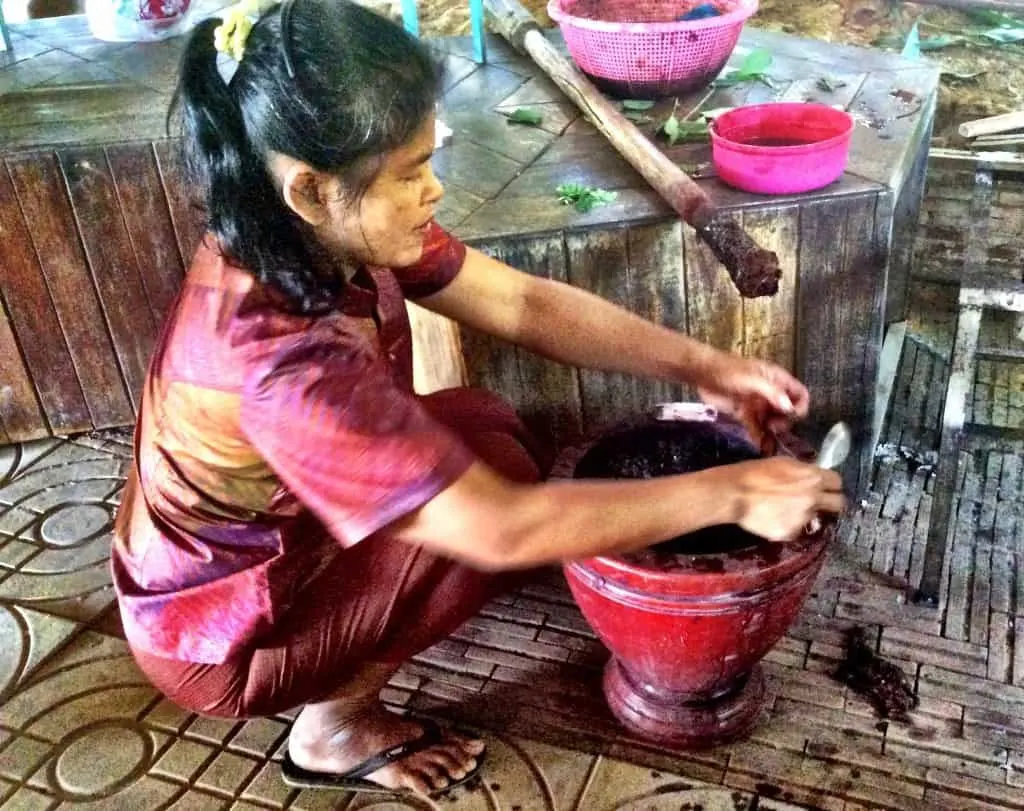
Silk is submerged in traditional dyes
In the Tha Sawang village outside of Surin, we walked down overgrown jungle pathways to a tall wooden house on stilts. In the dim light, we could barely discern how an elaborate loom system was operated by several artisans on different floors, keeping battens of warp thread in alignment for the complicated combinations.
The main weaver operated the treadles and shuttles dyed and silver weft threads in a dizzying process. It takes weeks to weave a centimeter in these intricate, three-dimensional patterns, called Pha Yok Thong.
In another village, Ban Arlue, villagers who still dress in traditional costume demonstrated the non-fade black dye process and different textures woven into their garments, danced with us in a flower-bedecked circle, and showed us how to string necklaces from soaked pods.
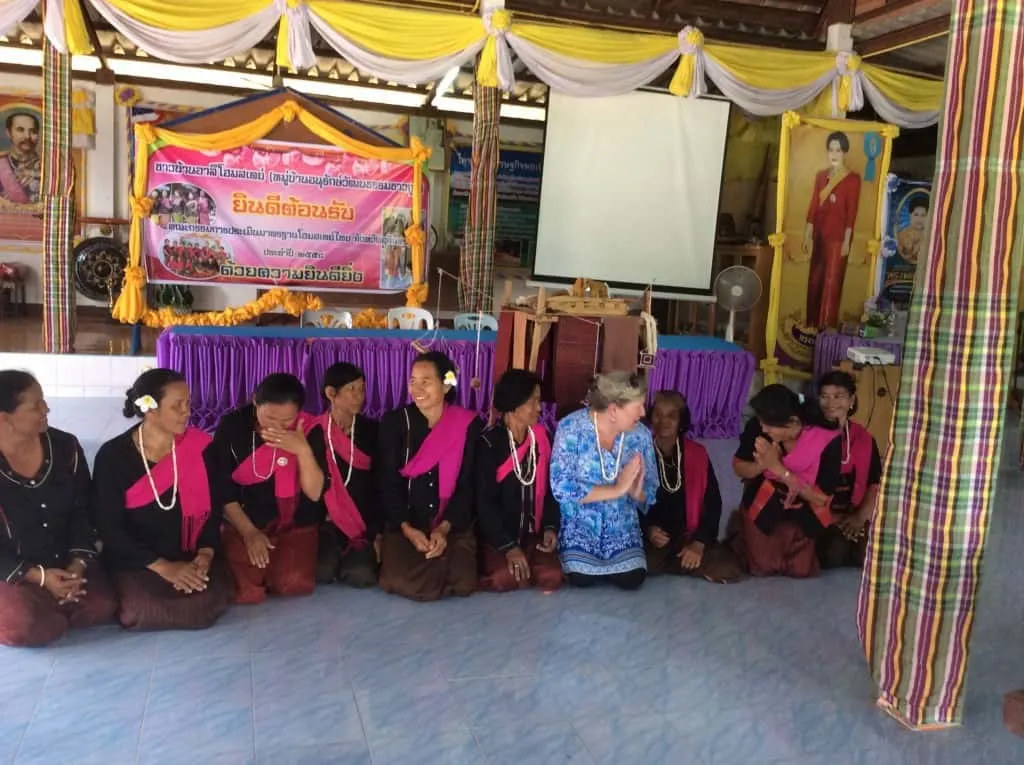
In Ban Khao Sinarin, multiple generations of Ban Chok villagers hammer, twist and coil tiny bits of silver to make Luk Pa Kueam buttons and jewelry in the ancient Khmer style.
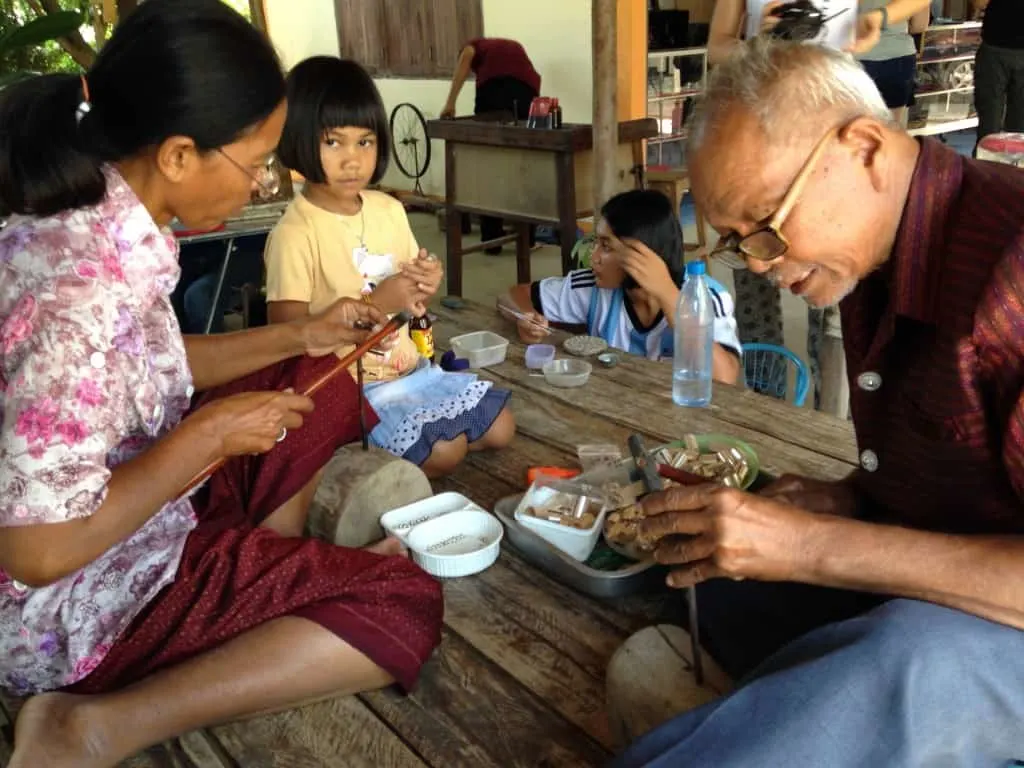
The methods appeared to have been unchanged over hundreds of years. Thailand’s Queen Sirikit has taken a special interest in promoting Thai handicrafts. Her patronage and initiatives ensure that these skills flourish.
It’s impossible to escape the spiritual overlay Khmer traditions hold in this region. Interspersed among larger cities such as Buriram, Surin and Ubon Ratchathani are some of the most significant temple ruins in Thailand.
On a direct migratory line from Angkor Wat and Phanom Rung to its southeast, Prasat Muang Tam is a thousand year old monument to the Hindu god, Shiva. Constructed in the Khmer style, it is distinguished by its symmetrical design featuring reflecting pools filled with sacred lotus.
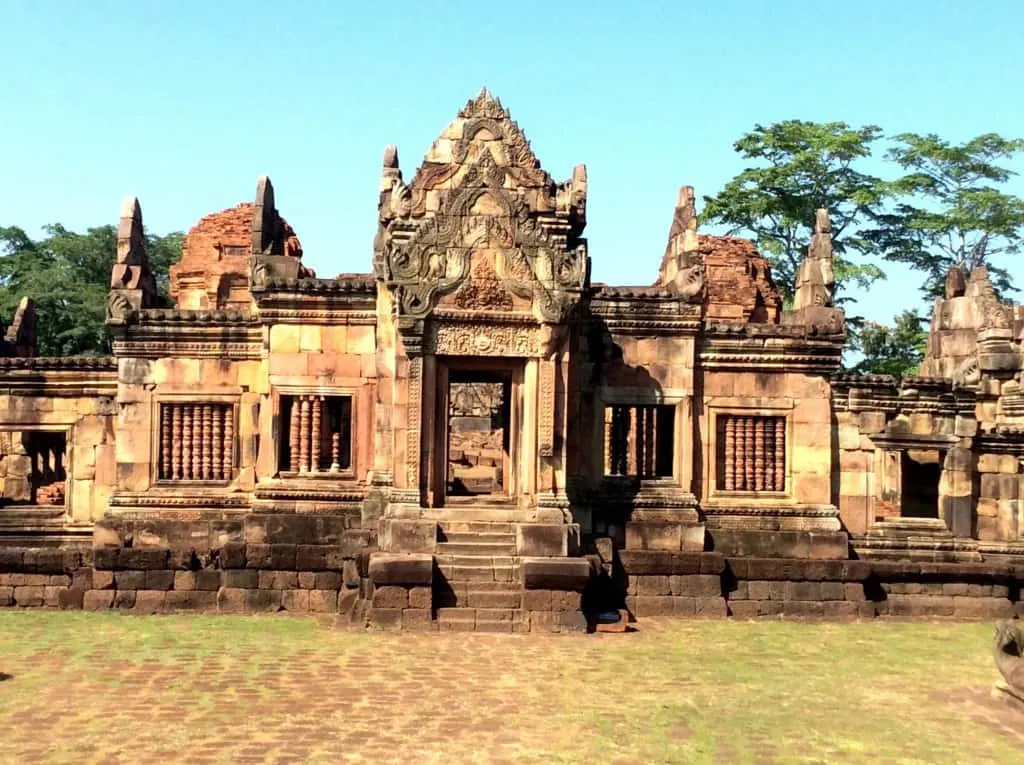
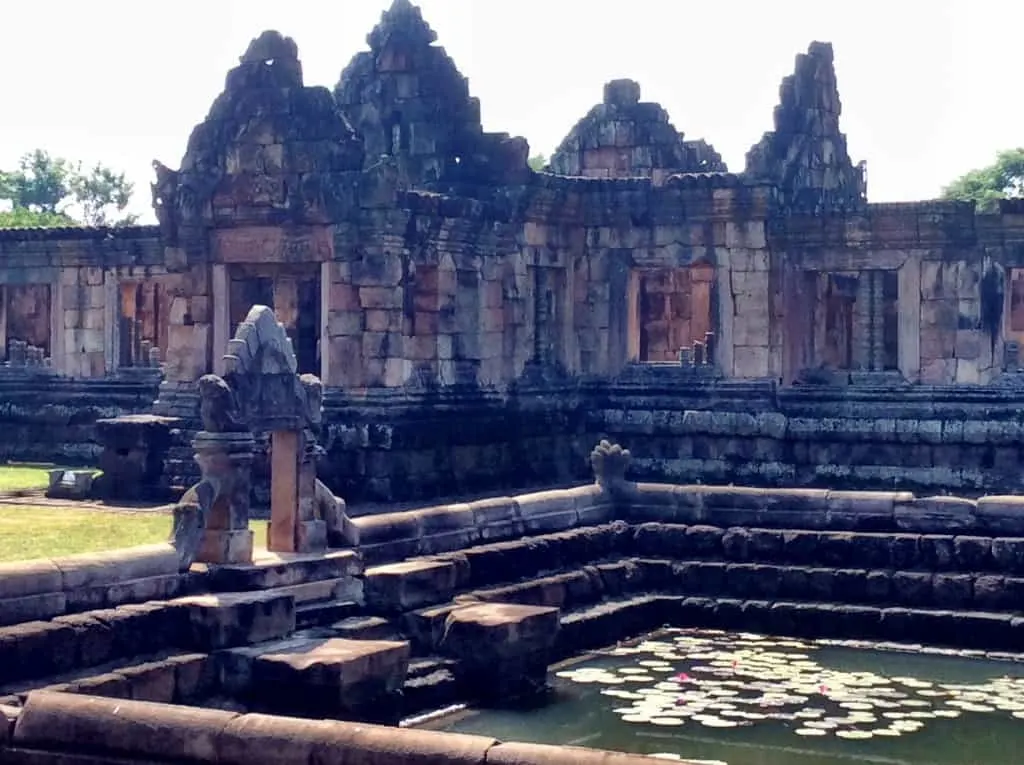
About 15 minutes away is the stunning Phanom Rung temple complex, built upon the rim of an extinct volcano. Rising to approximately 1300 feet in elevation, this temple was also a shrine to Shiva, representing his heavenly dwelling. The temple is in alignment with the sun twice each spring and fall, sunset and sunrise, where it will shine through all 15 of the sanctuary’s doors. Pilgrims flock to be present during these auspicious moments.
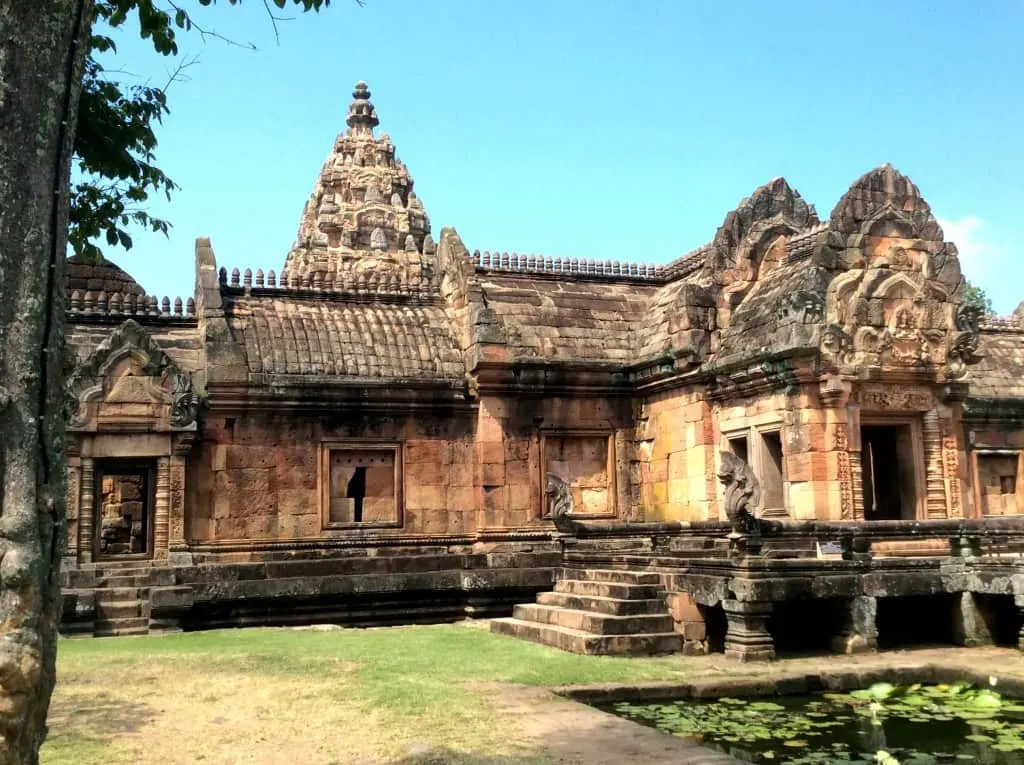
More than anything, food is what makes Isaan the heart of Thailand. Regional specialties such as spicy papaya salad (which is like a shredded slaw), Isaan sausage, sticky rice in bamboo, and split roasted chicken are favorites we returned to again and again throughout the following weeks.
Sometimes we knew what we were eating: beautifully evocative morning glory stems or lotus kernels, gorgeous cakes adorned with fruit and coconut frosting.
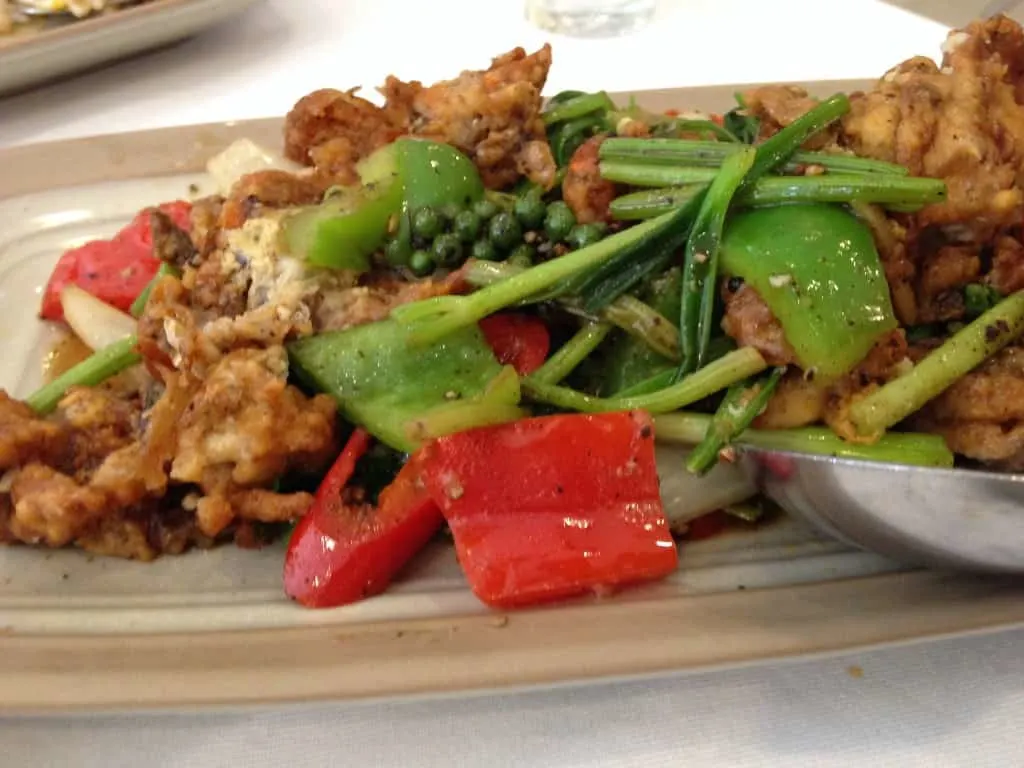
Other times, we had no idea what was on the plate, or what to order from the menu. For help, we turned to our friend Lek Supatchai, of Le Isaan Restaurant in Bangkok, to give us the lowdown on Isaan street food:
Isaan is not only the least-visited region in Thailand, but it is also economically disadvantaged by comparison with the rest of the Kingdom. Farm families are often heavily in debt and growing conditions, while improved, are still challenging.
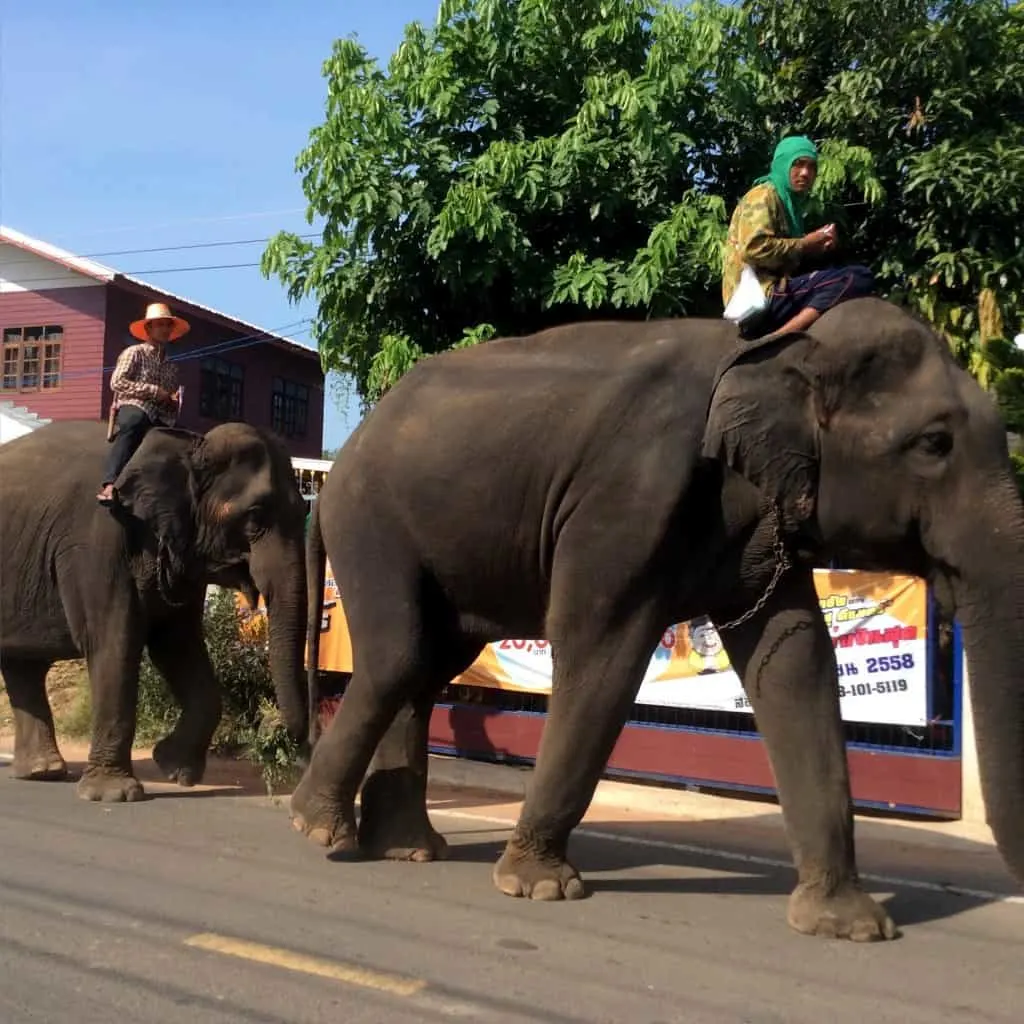
While Isaan’s economy is the fastest growing in Thailand, approximately two million people leave the region each year to seek work. Our restauranteur friend Lek was one of them. His story is echoed (see our inspiring video interview with him here) by the thousands in Bangkok: survival level wages, sleeping on the streets, holding multiple low-paying jobs, sending money home, and returning home temporarily to help during rice planting season.
Despite these challenges, we think now is an opportune moment for travelers to visit this littler known part of Thailand. Prices are even lower than the rest of the country, making it a highly affordable option for lengthier stays. But most importantly, the people will welcome you exuberantly as you take in the rich culture, spirit and cuisine that make Isaan the heart of Thailand.
Pinnable Images:
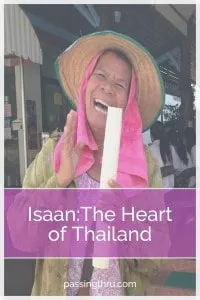
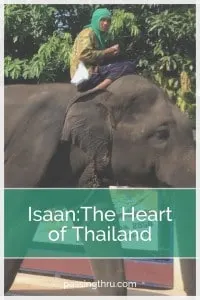

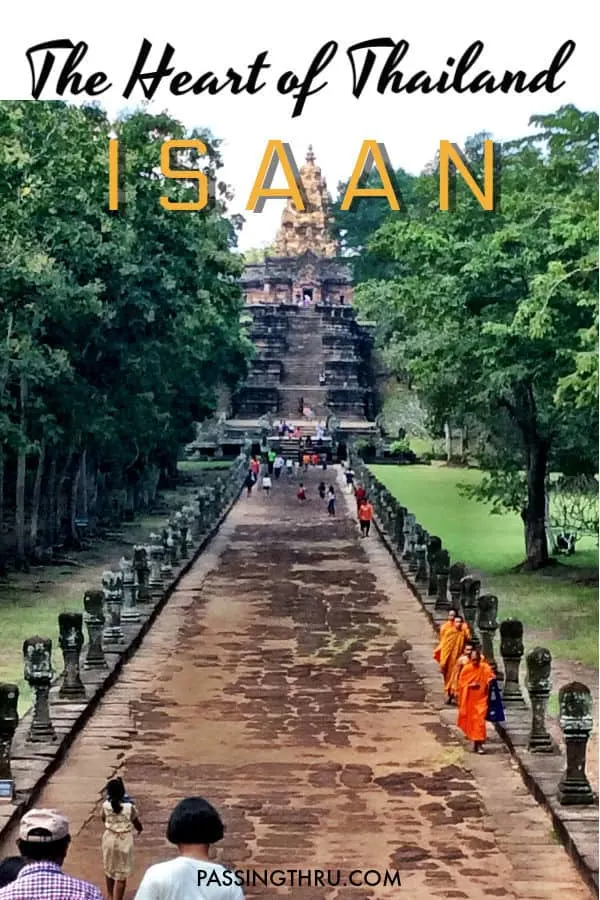
Disclosure: Our experience in Isaan was complimentary in conjunction with TBEX Asia 15, Thai Tourism Authority and the Association of Thai Travel Agents.
Tips and Practicalities:
Isaan is easily reached by air from Bangkok, with multiple flights daily to Ubon Ratchathani and other cities in the region. Frequent bus and train departures serve multiple stations as well.Surin is about a two and one-half hour drive from Ubon Ratchathani. Roads are well-paved and the highway network is newer. Thai drivers can be intrepid passers, and there is significant motorbike and truck transport on the highway system.
Thong Tarin Hotel, Surin offers more than 200 guest rooms, restaurant and bar, conference facilities and swimming pool. While self-billed as a luxury hotel, rooms are a bit spartan, yet still comfortable and very spacious.
Celebrate Restaurant in Surin serves Thai-Southern Isaan cuisine with family style tasting menu and a la carte selections. Excellent service.
Green Terrace Restaurant in Surin serves Isaan cuisine with outdoor terrace seating adjacent to traditional water feature and koi pond. Excellent service.
Le Isaan Restaurant and Wine Bar in Bangkok’s Suanplu Soi 8 neighborhood offers an award-winning fusion menu of Isaan specialties with French overtones, full complement of wines and cocktails in a serene, feng shui inspired atmosphere.
Tips for Trip Success
Book Your Flight
Find an inexpensive flight by using Kayak, a favorite of ours because it regularly returns less expensive flight options from a variety of airlines.
Book Your Hotel or Special Accommodation
We are big fans of Booking.com. We like their review system and photos. If we want to see more reviews and additional booking options, we go to Expedia.
You Need Travel Insurance!
Good travel insurance means having total peace of mind. Travel insurance protects you when your medical insurance often will not and better than what you get from your credit card. It will provide comprehensive coverage should you need medical treatment or return to the United States, compensation for trip interruption, baggage loss, and other situations.Find the Perfect Insurance Plan for Your Trip
PassingThru is a participant in the Amazon Services LLC Associates Program. As an Amazon Associate I earn from qualifying purchases.
To view PassingThru’s privacy policy, click here.

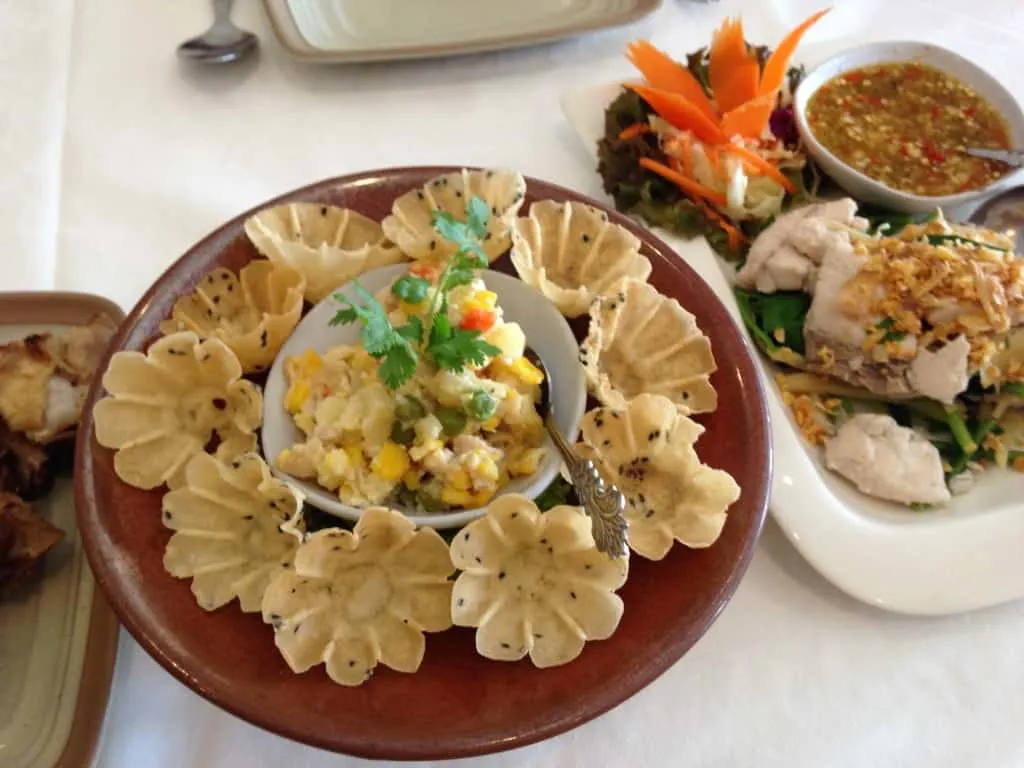
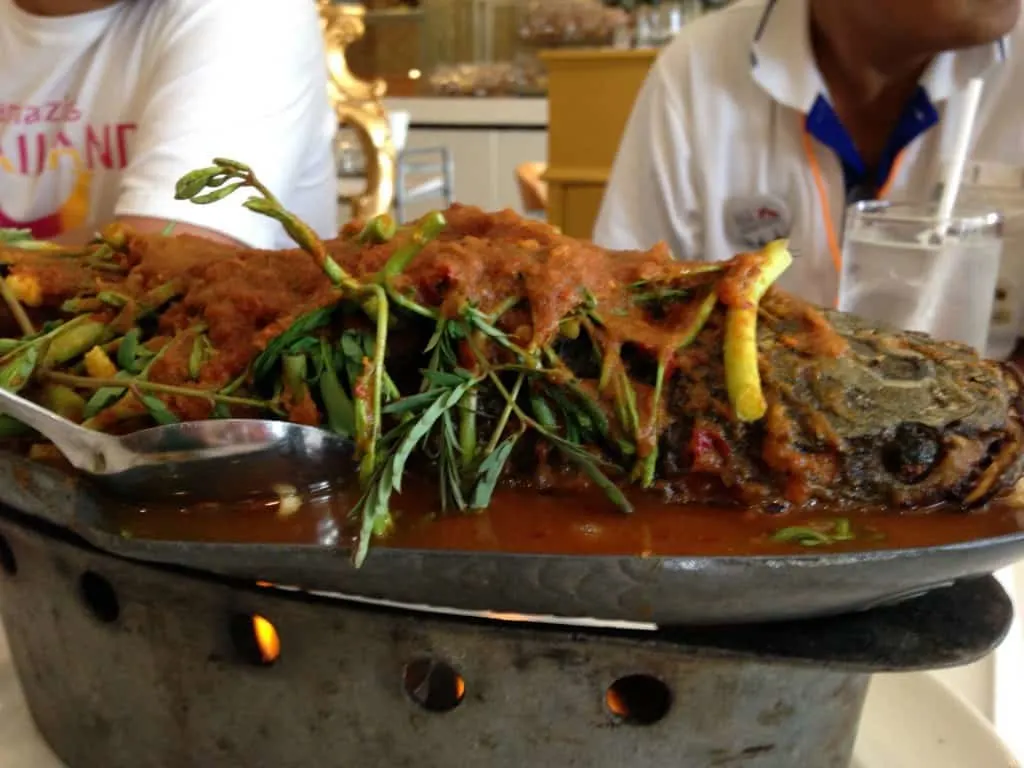

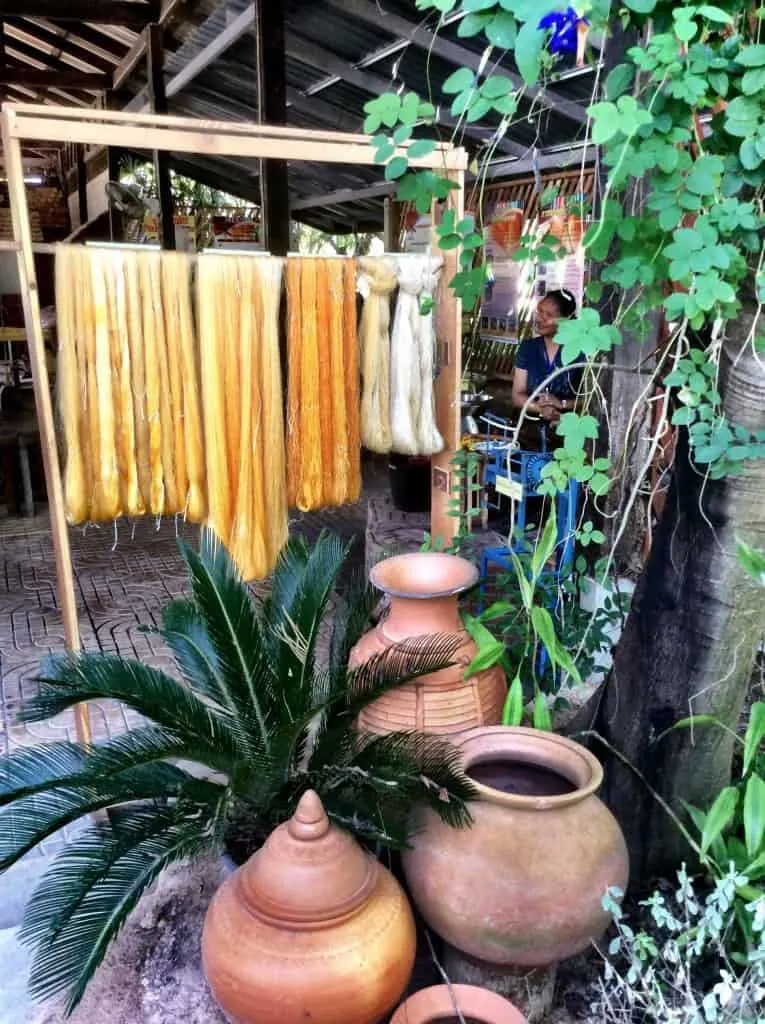
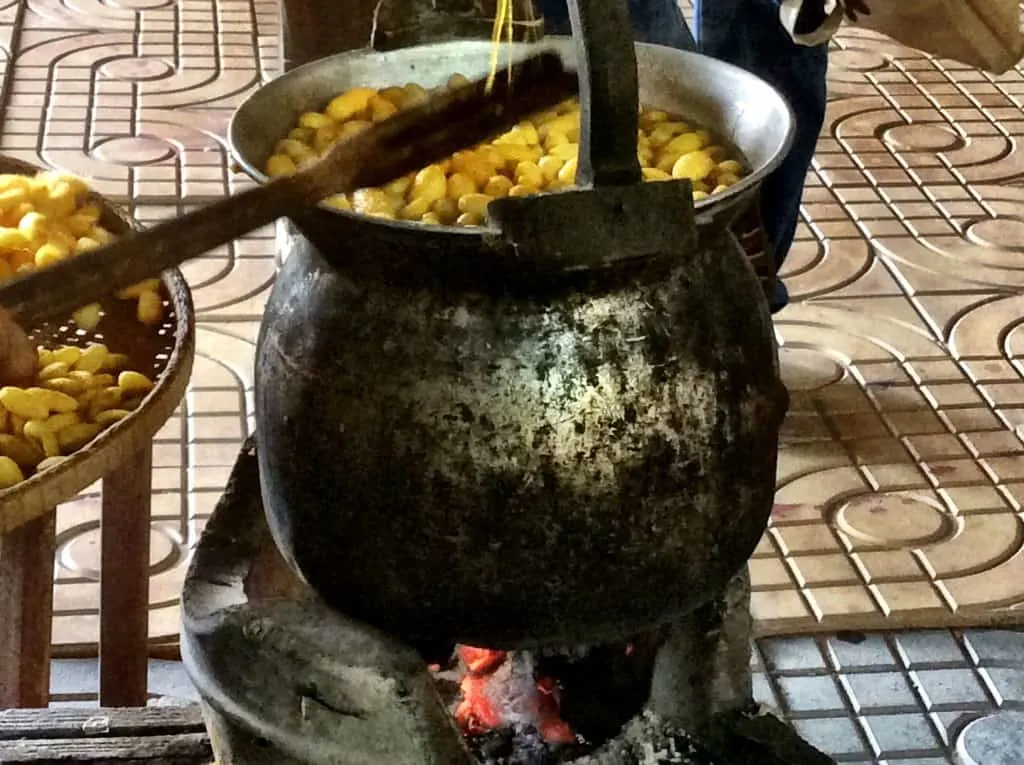
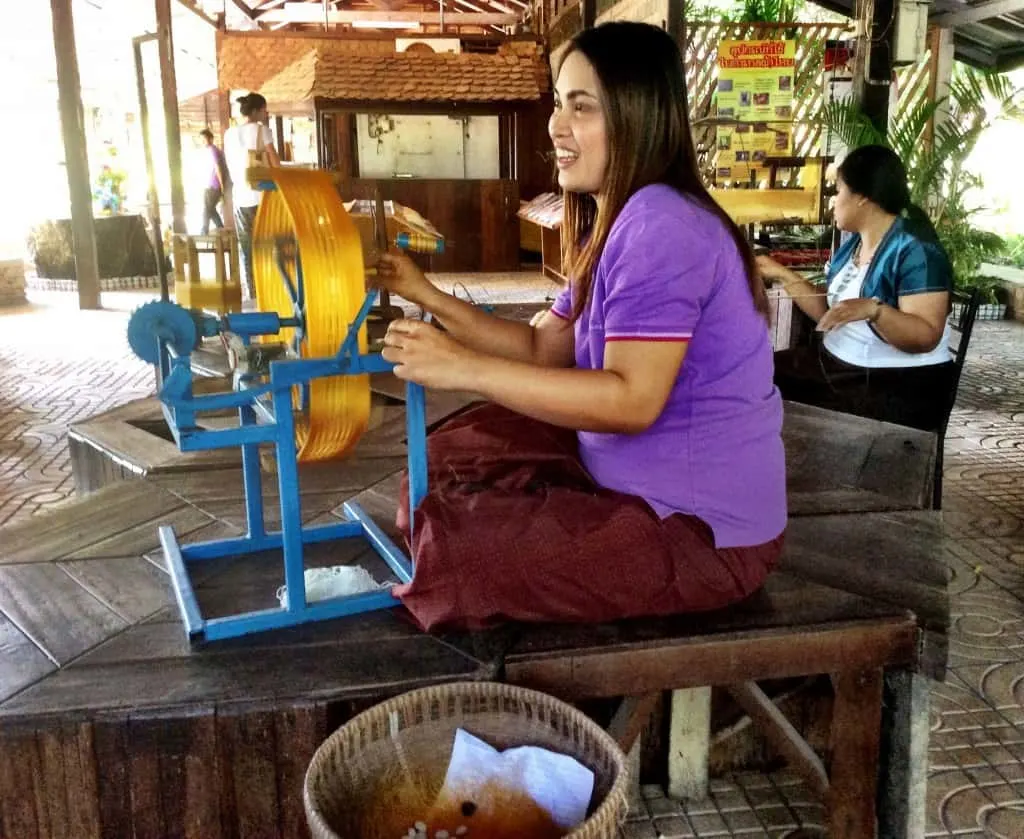
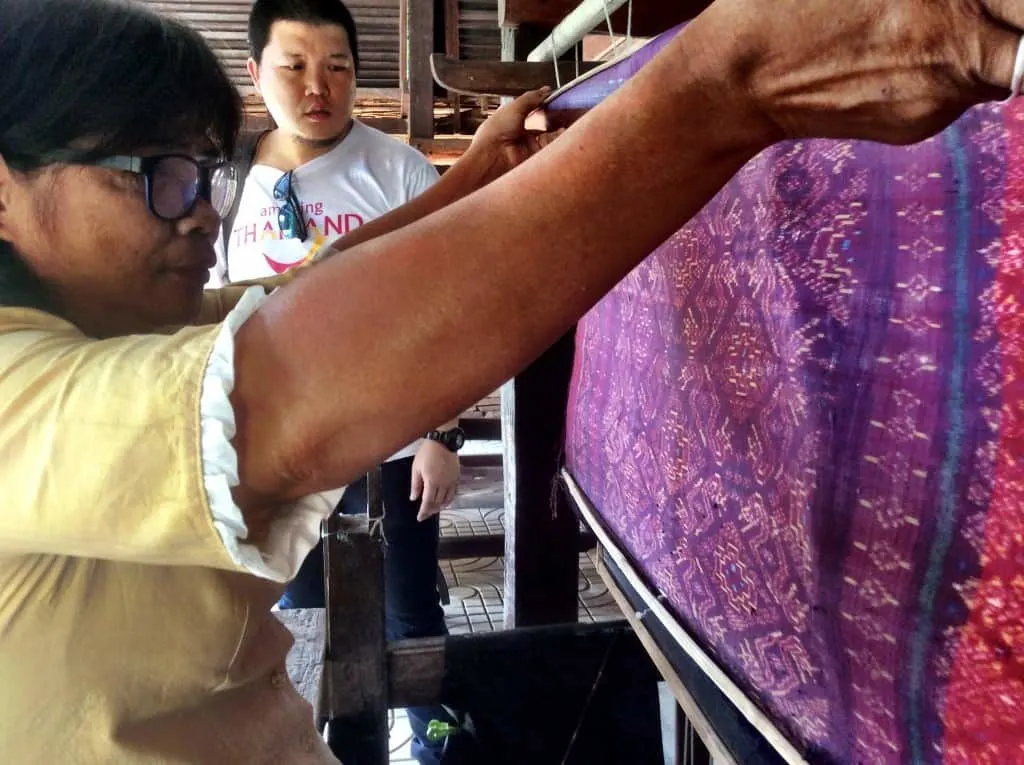
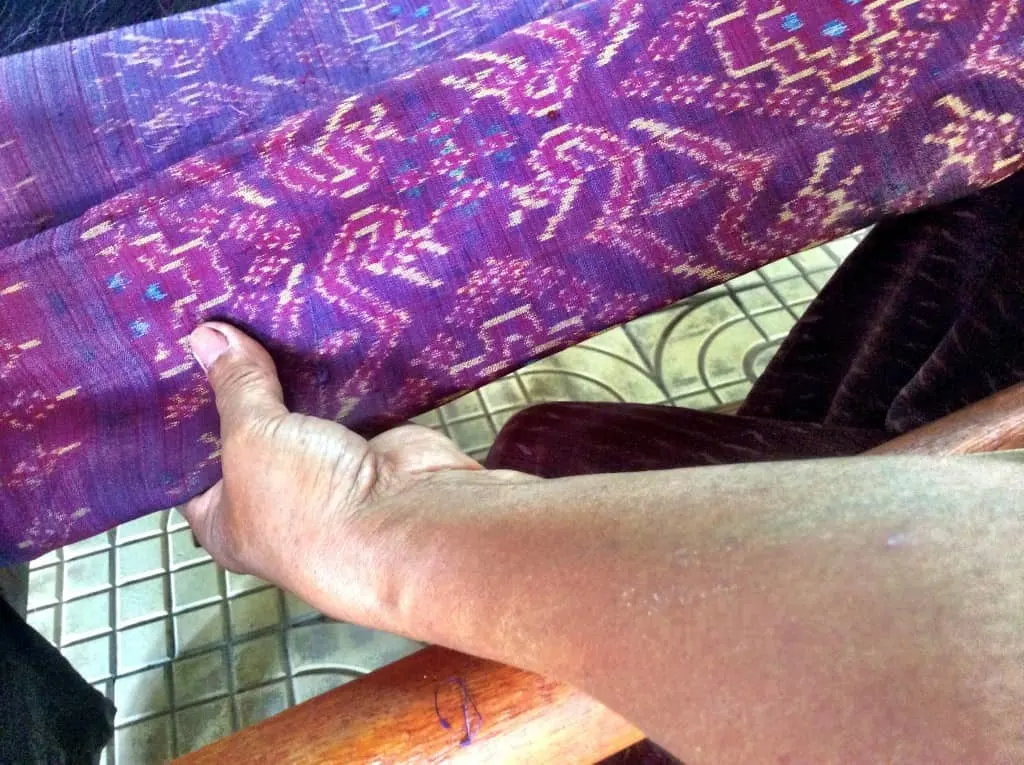
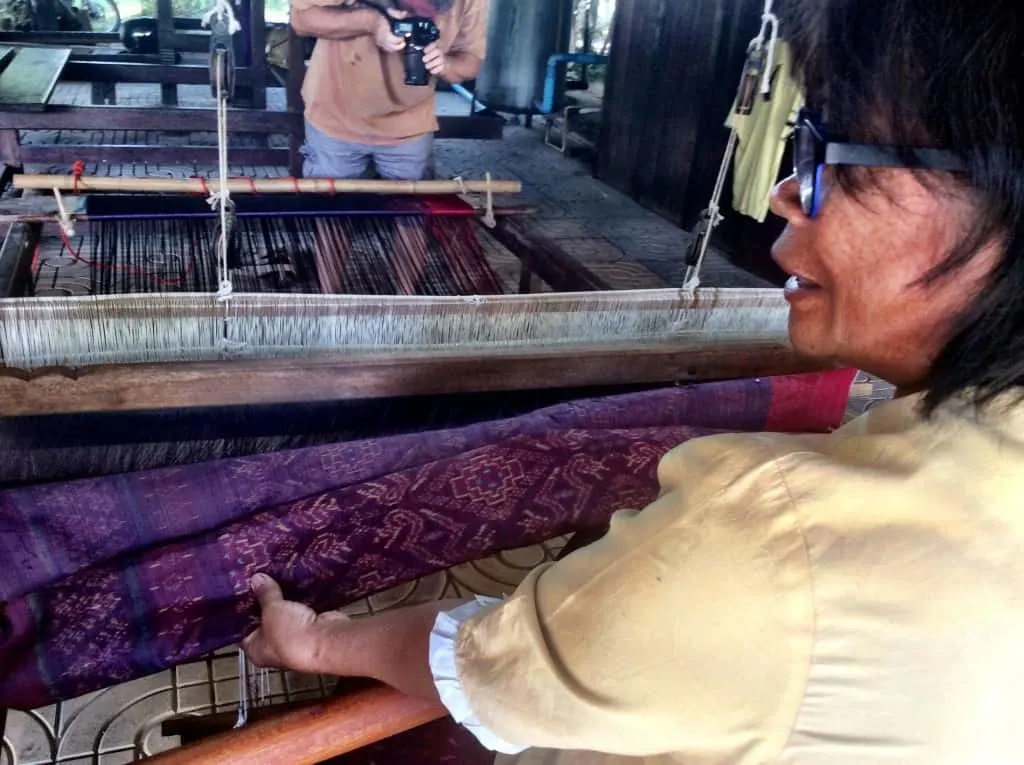
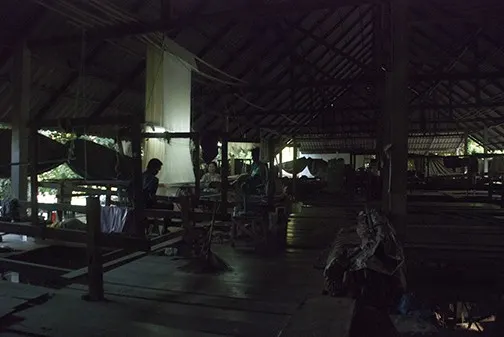
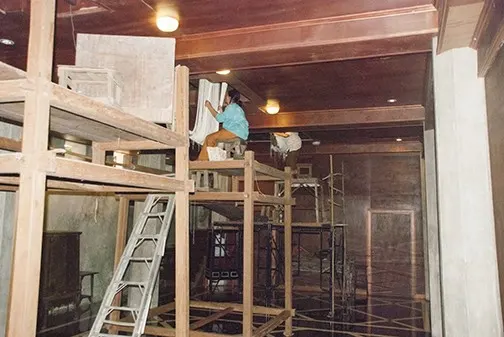

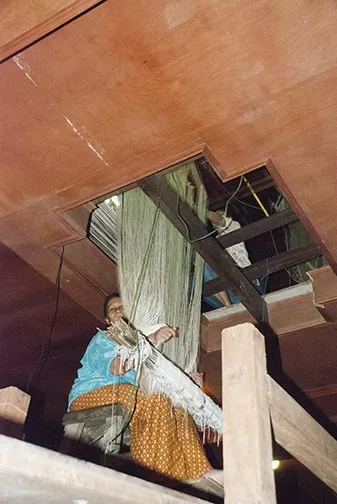
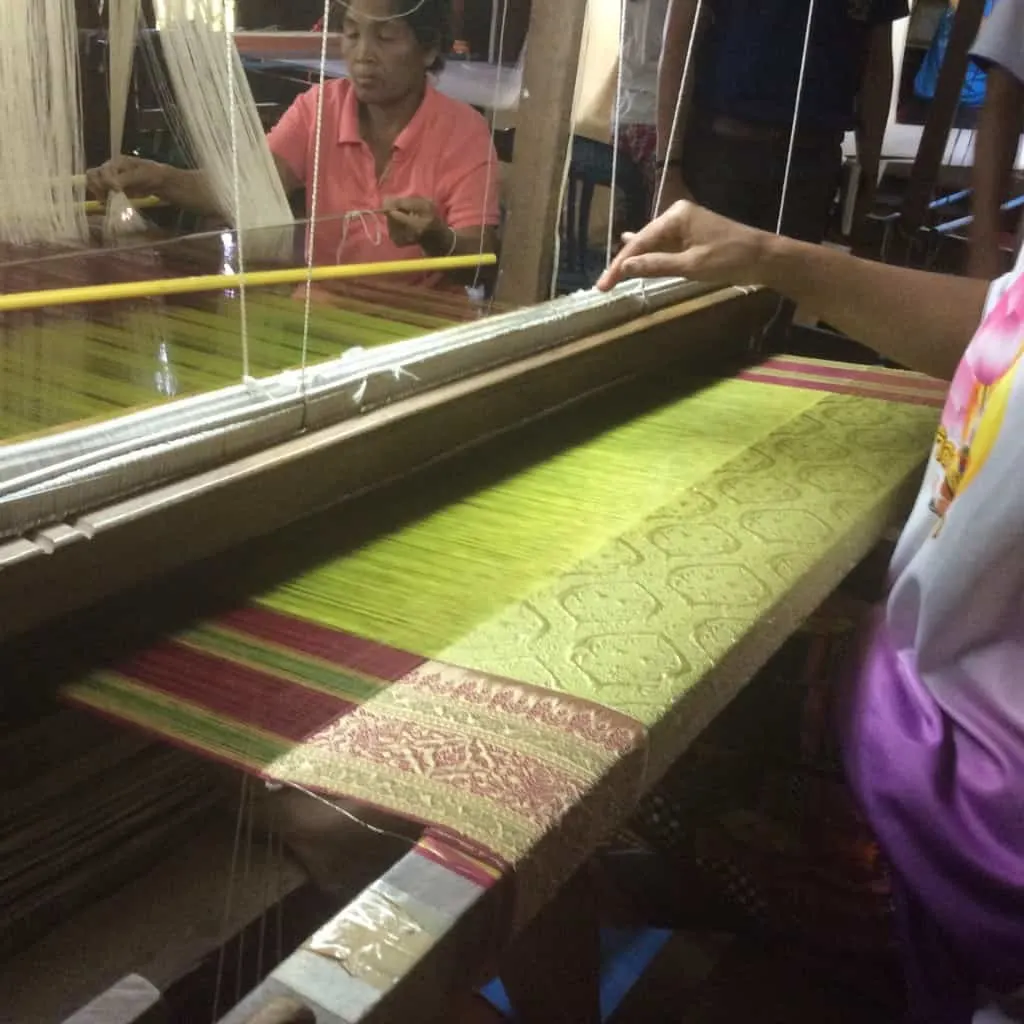
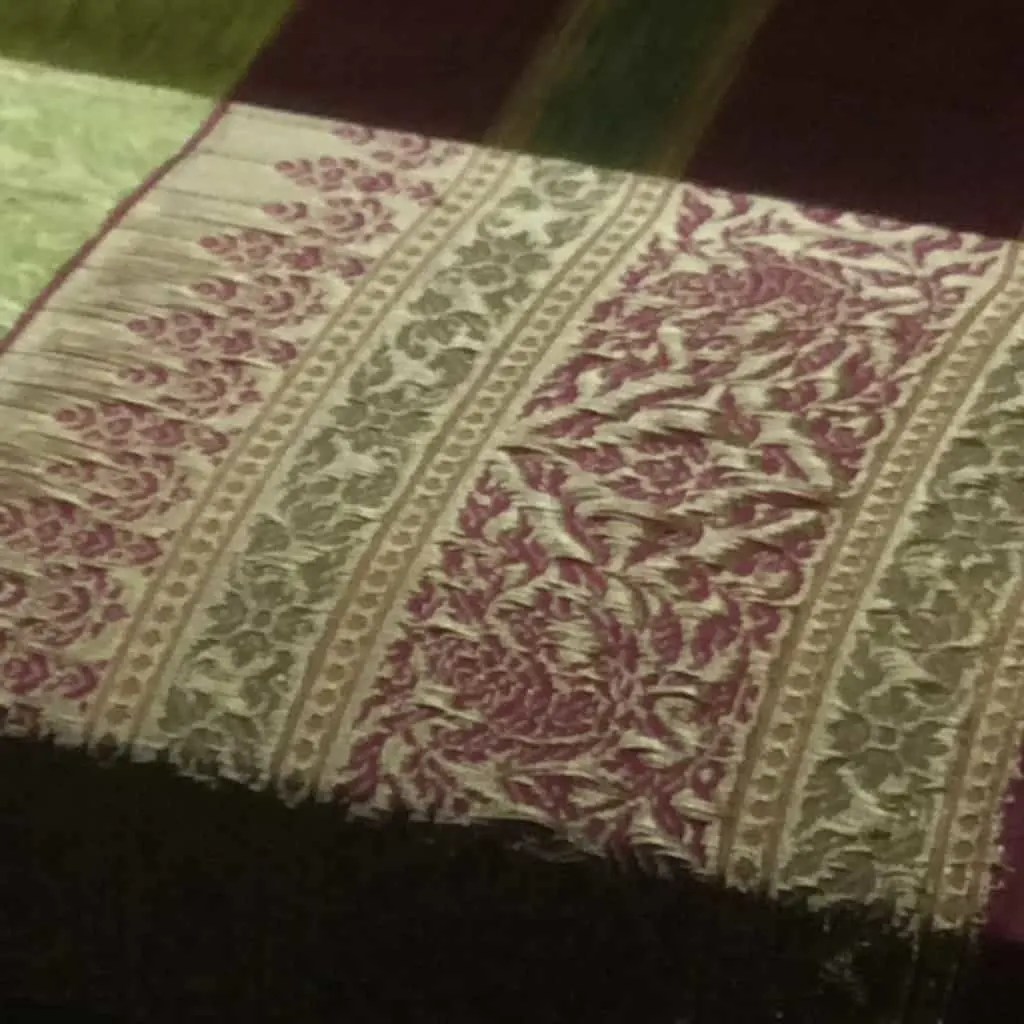
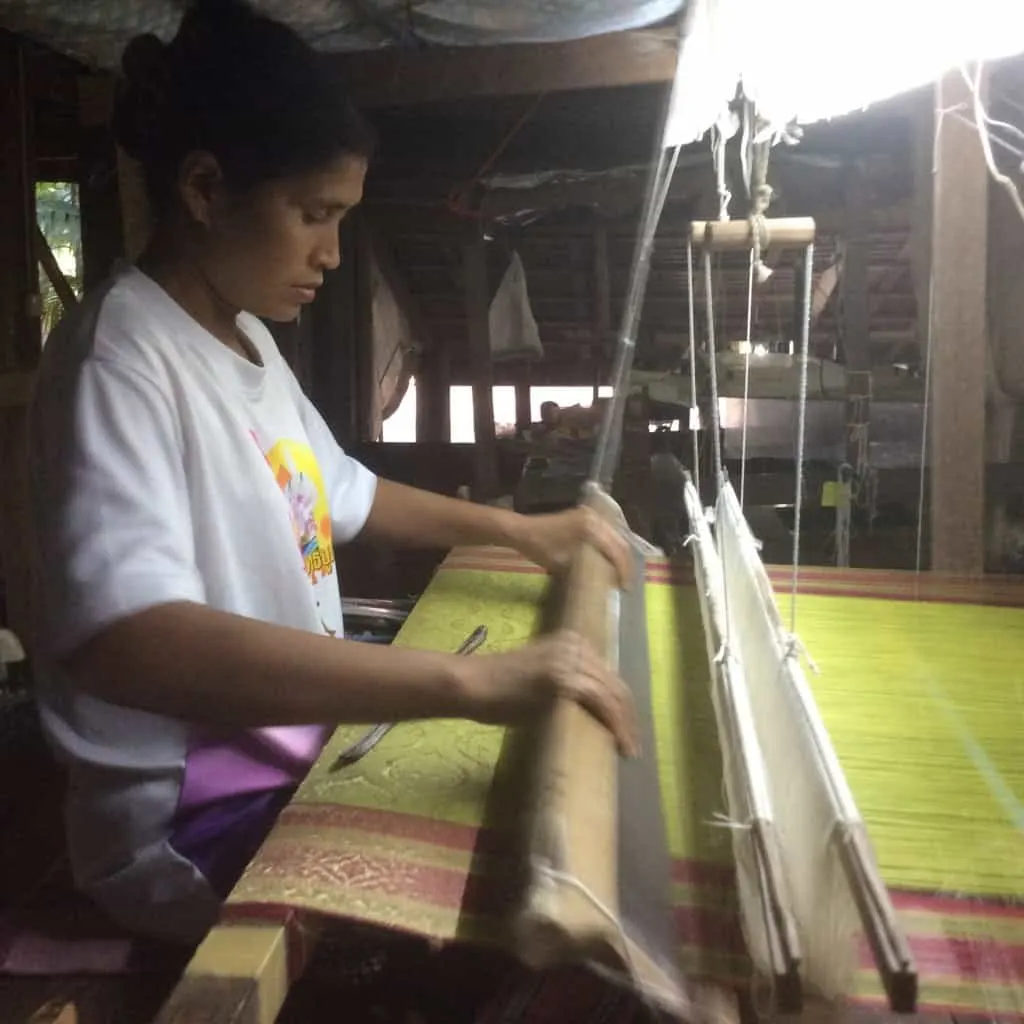
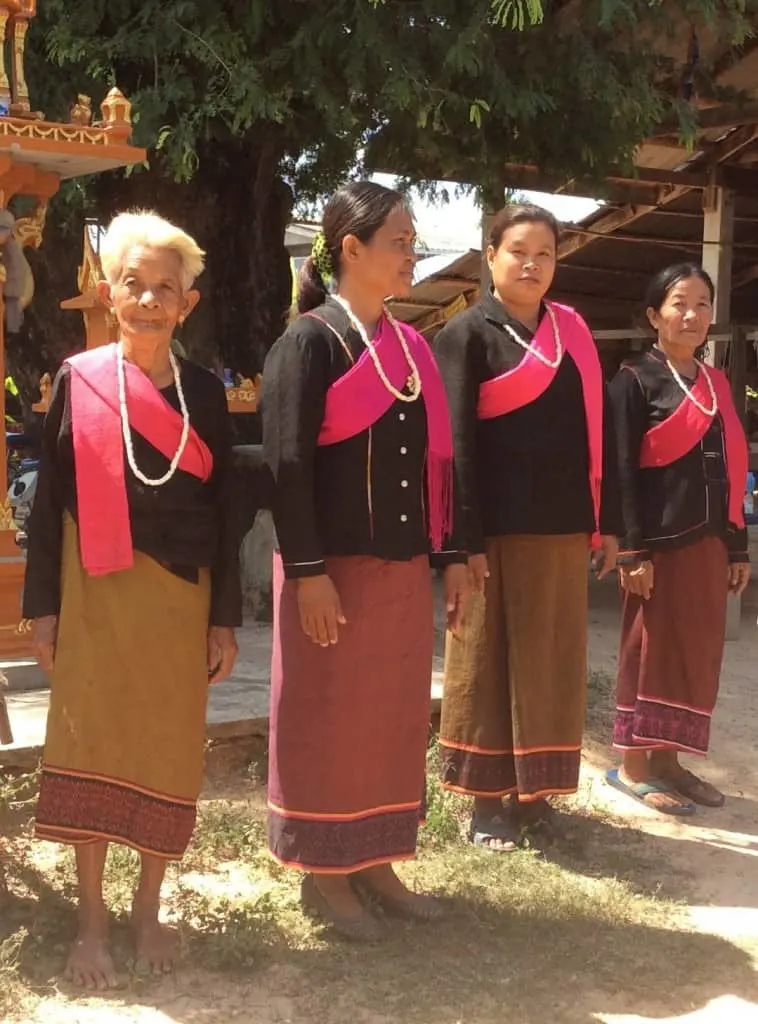
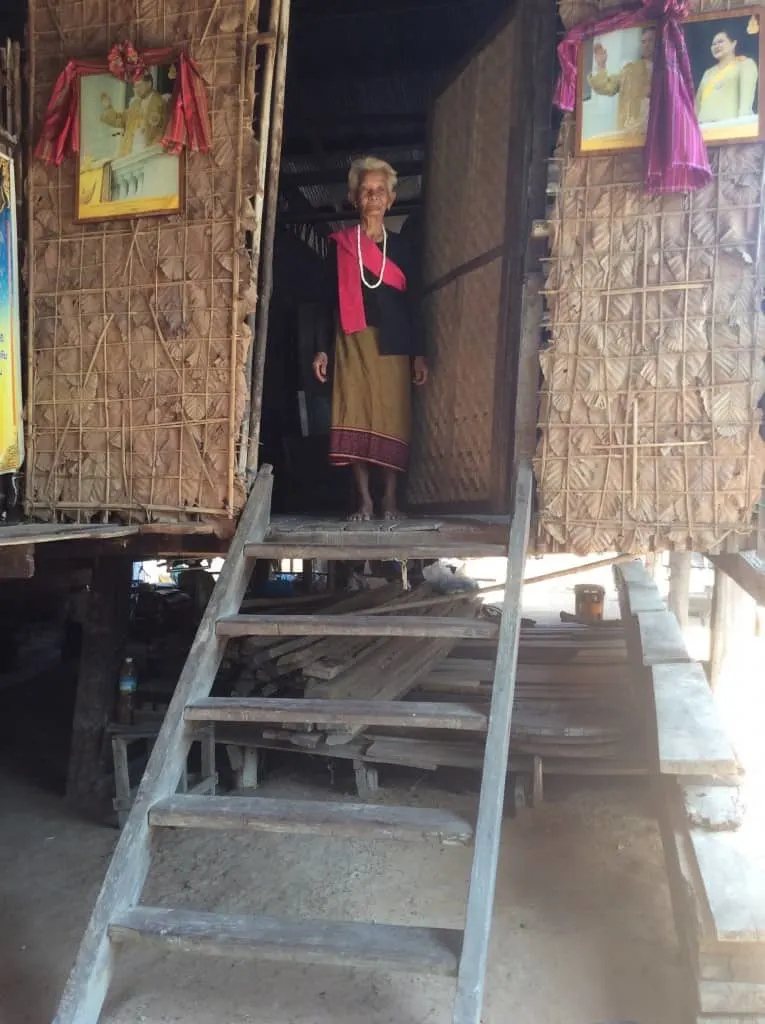
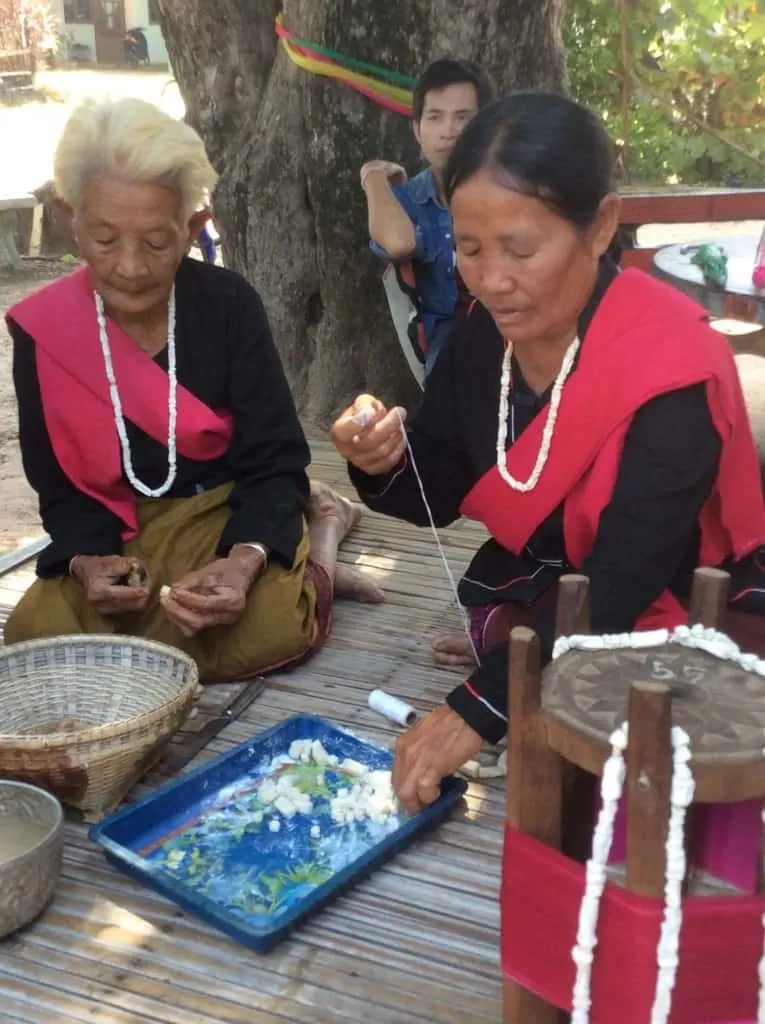
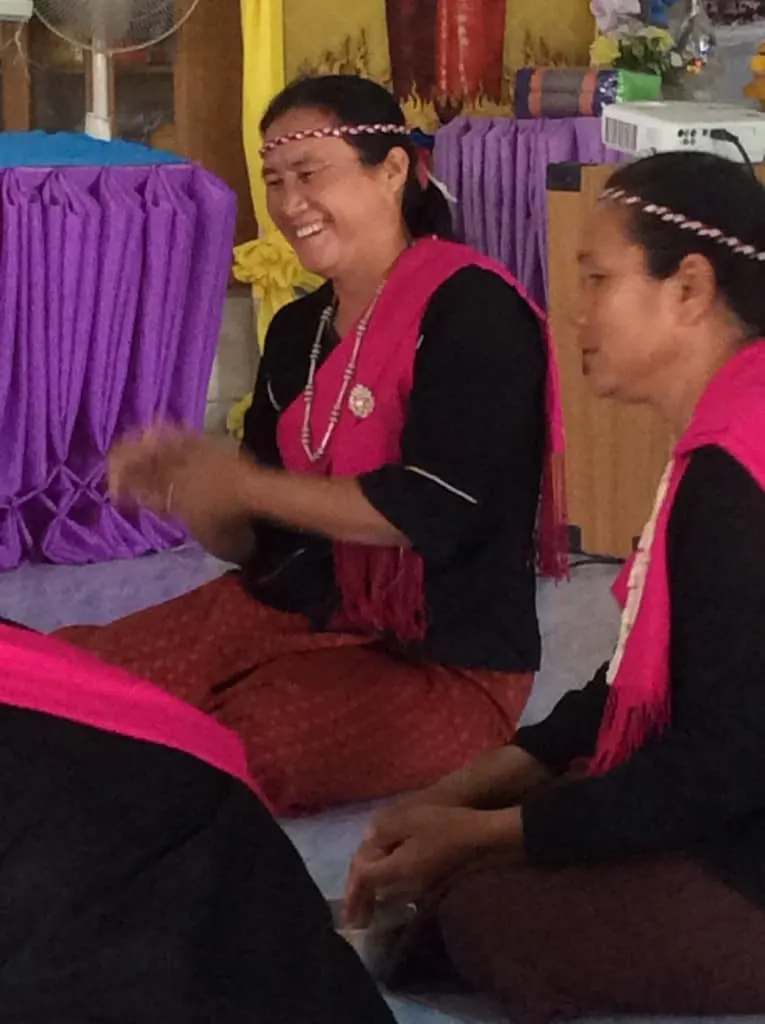
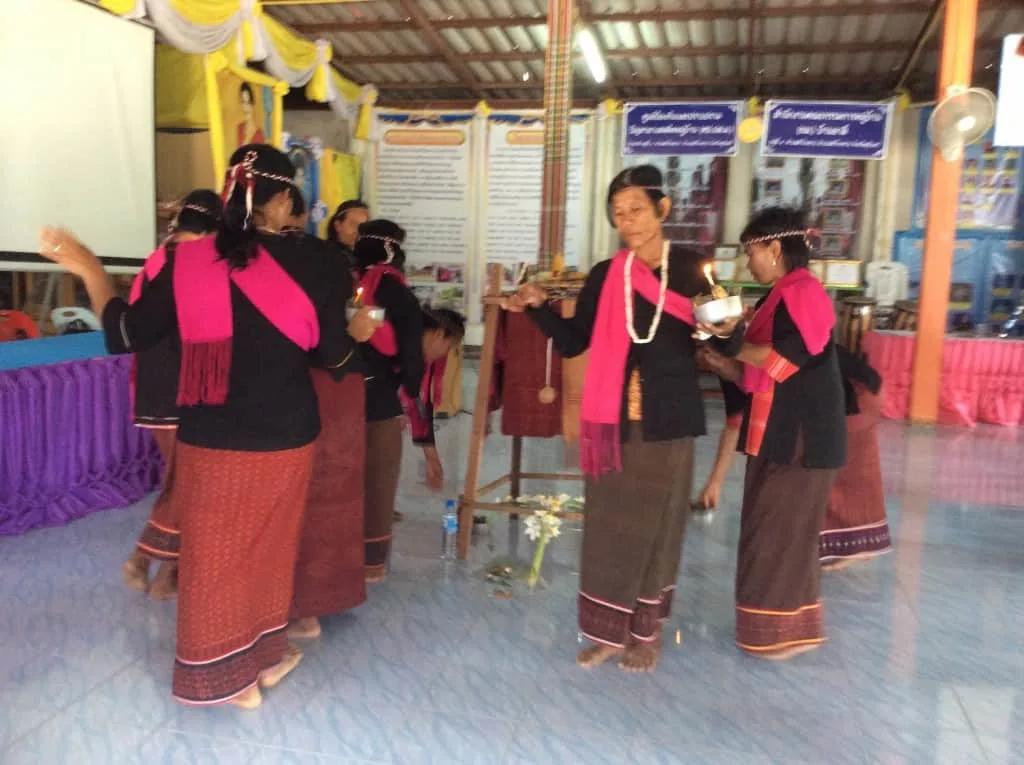

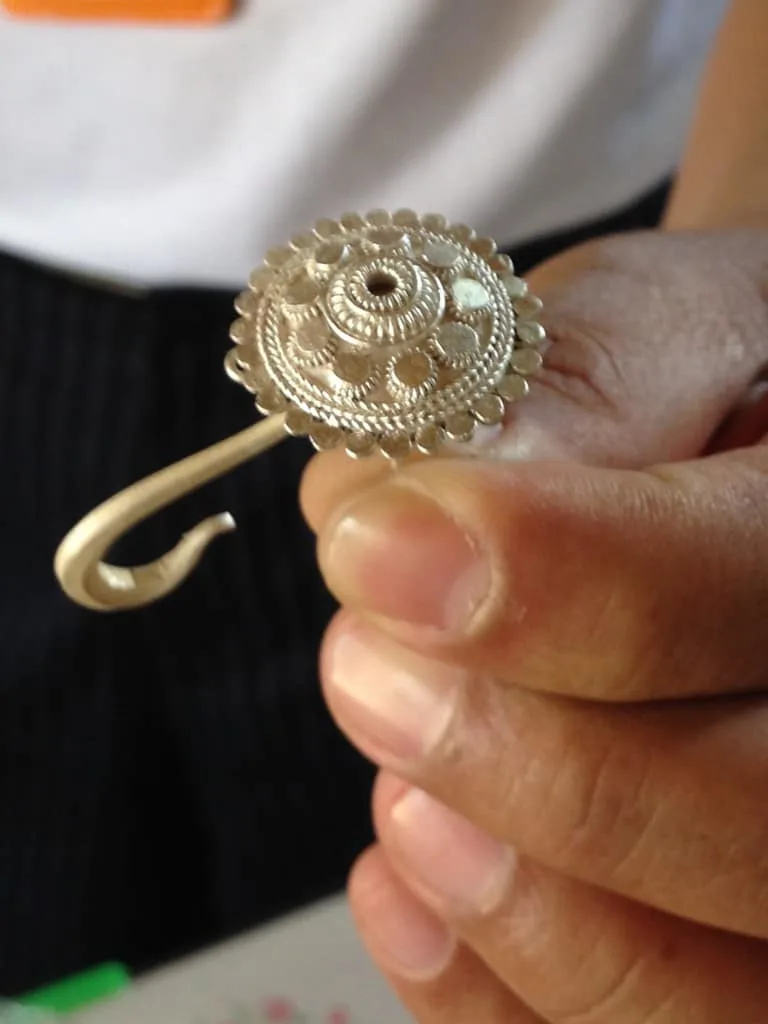
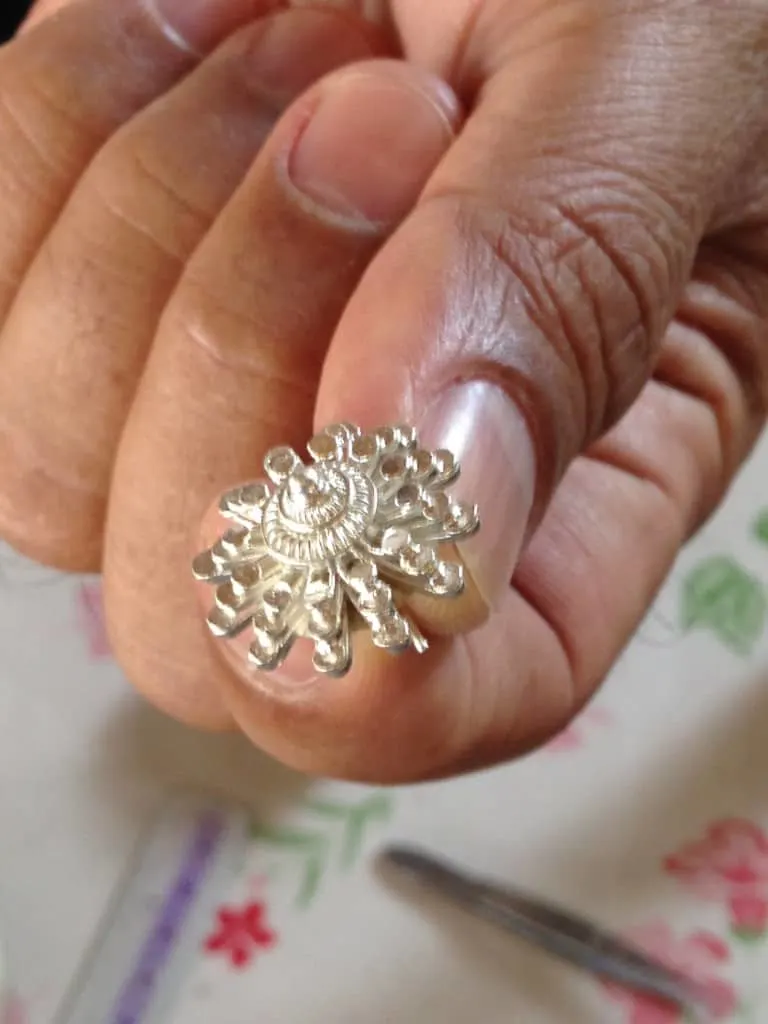
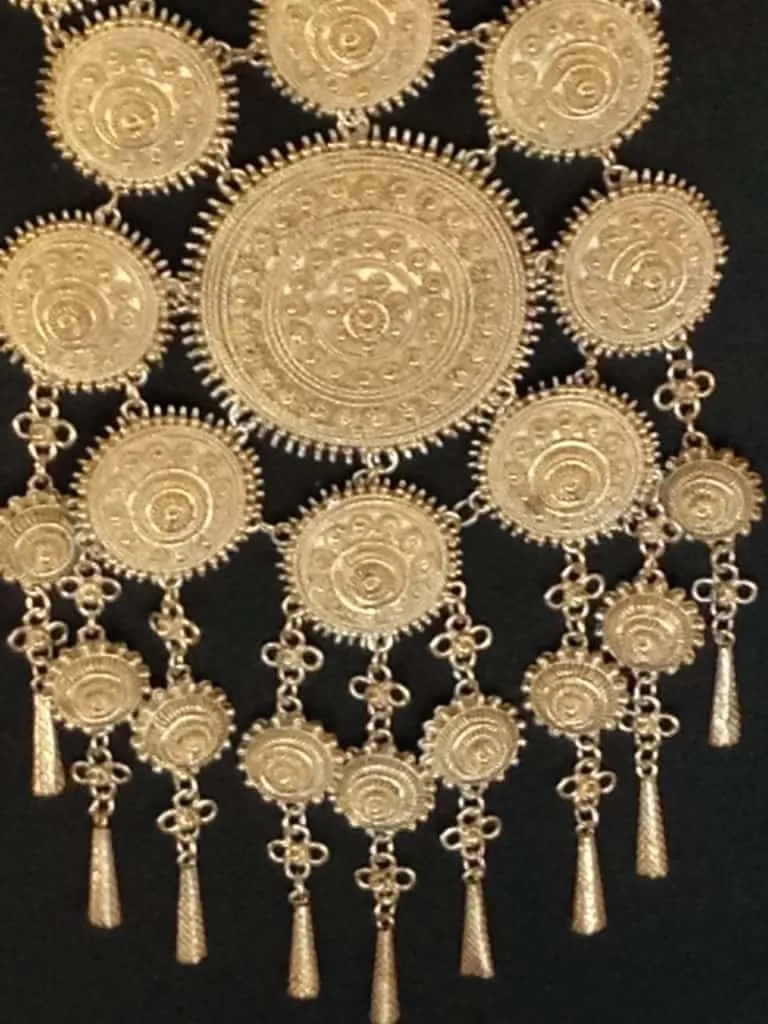
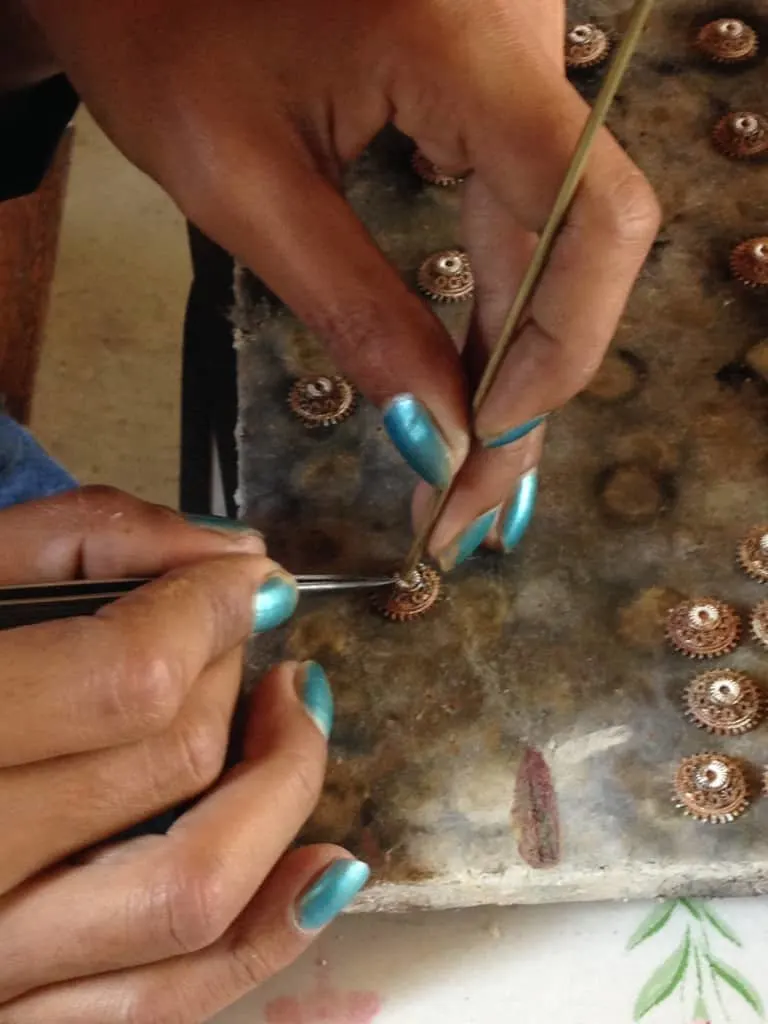

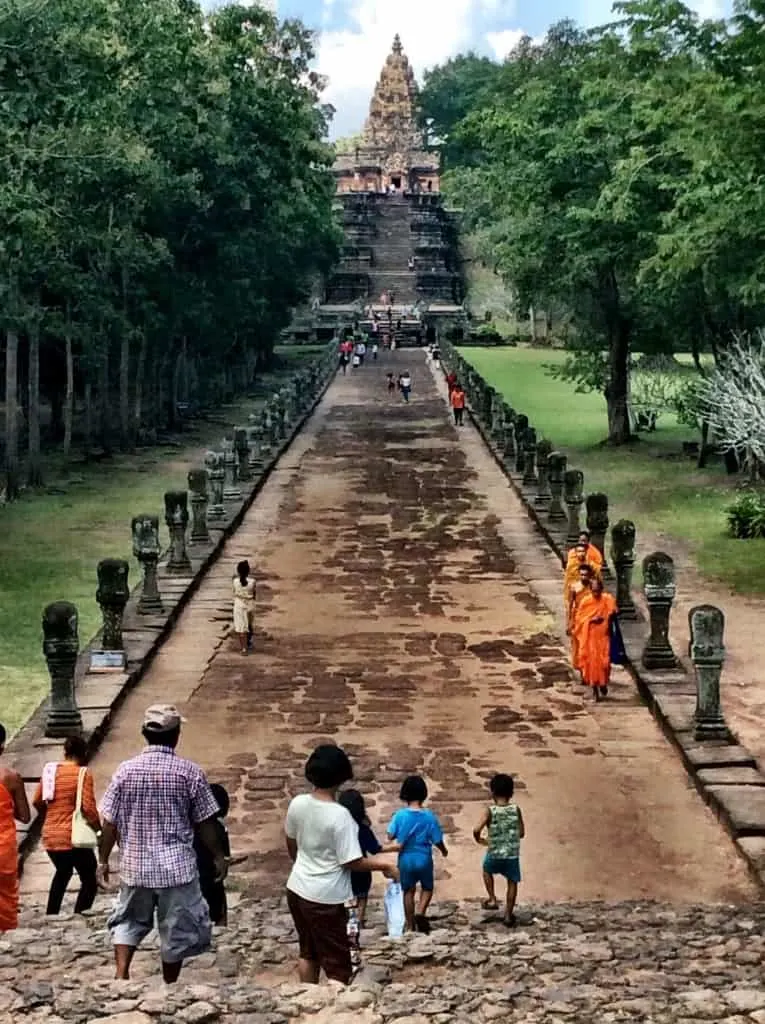
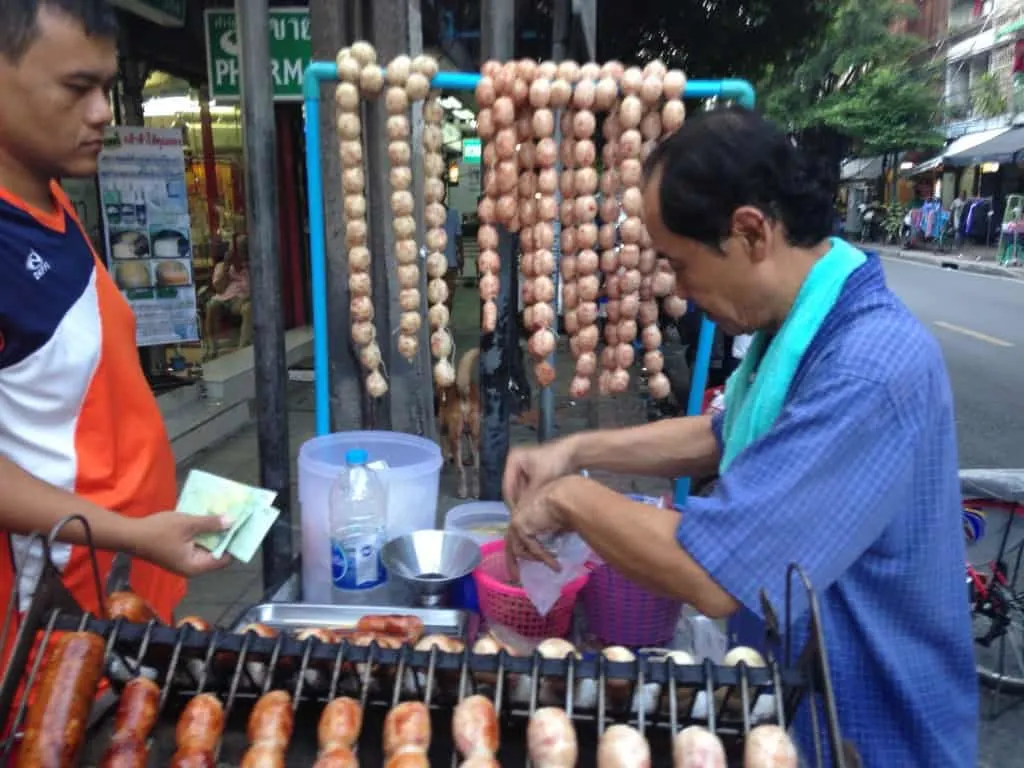
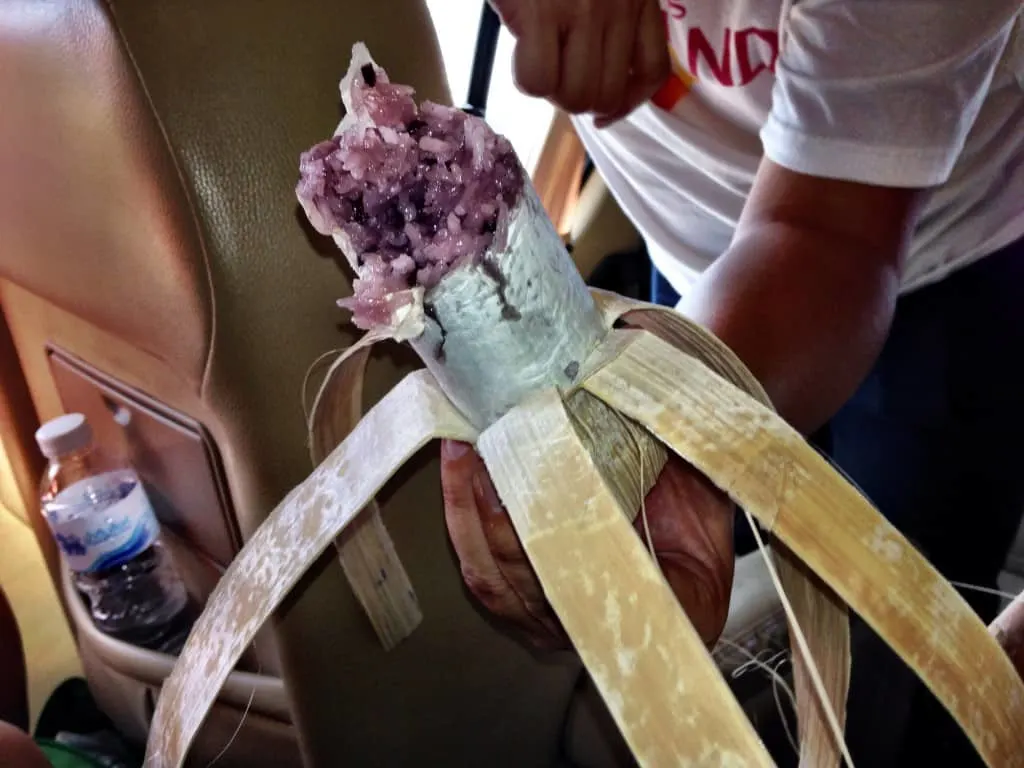
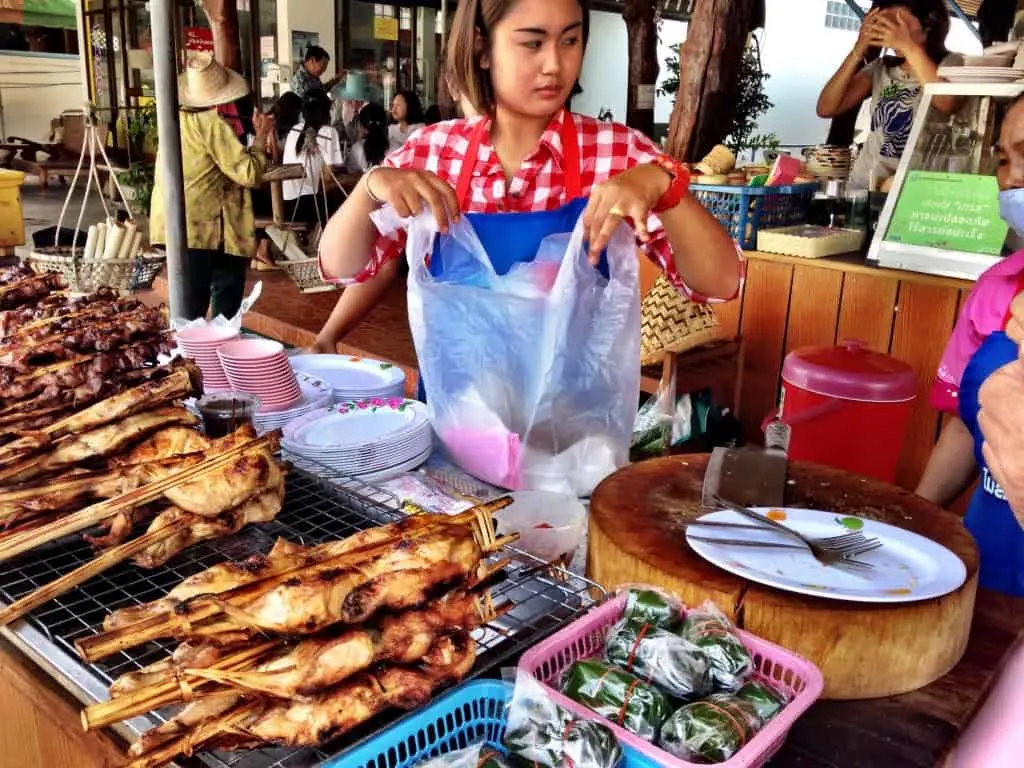
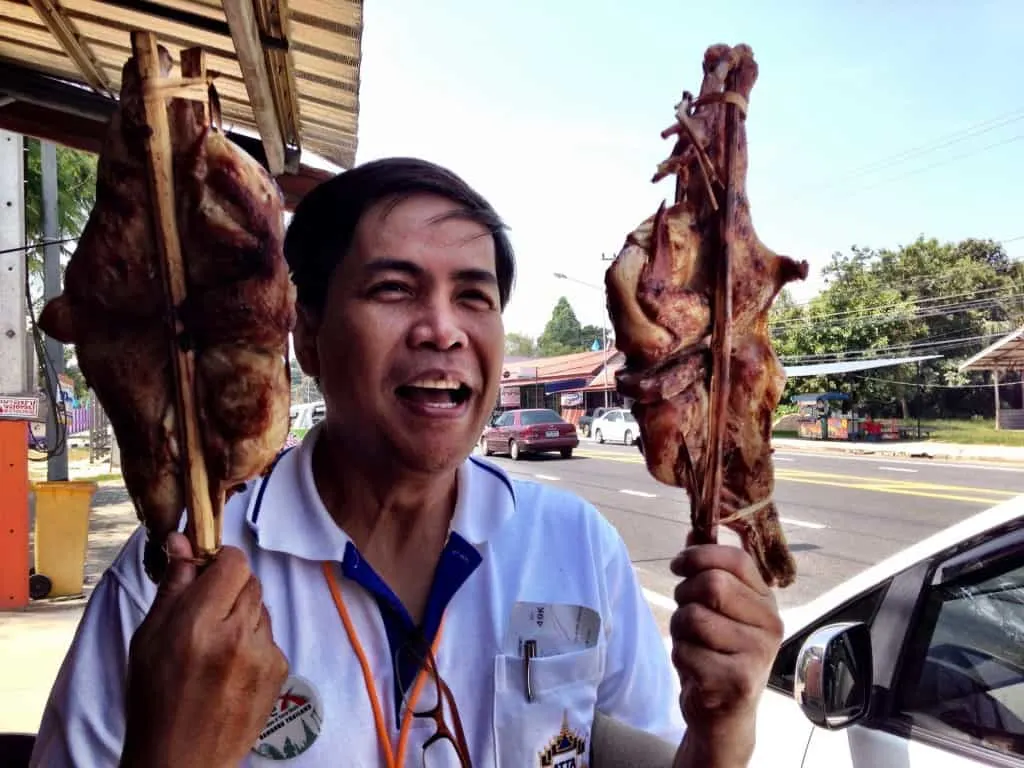
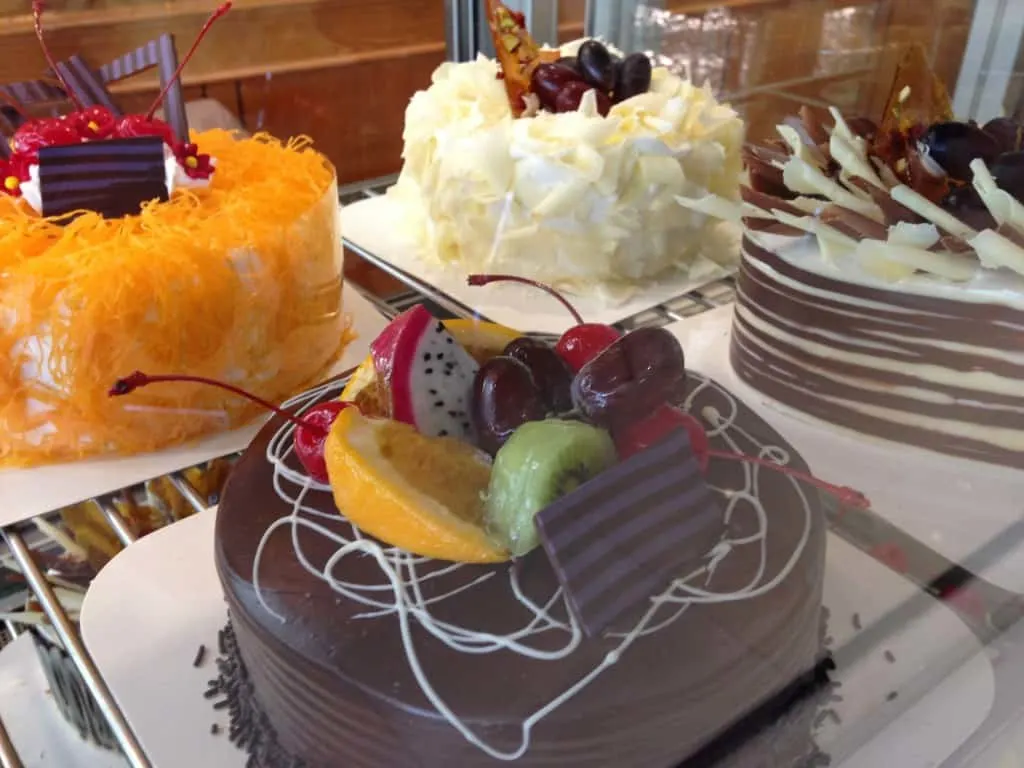
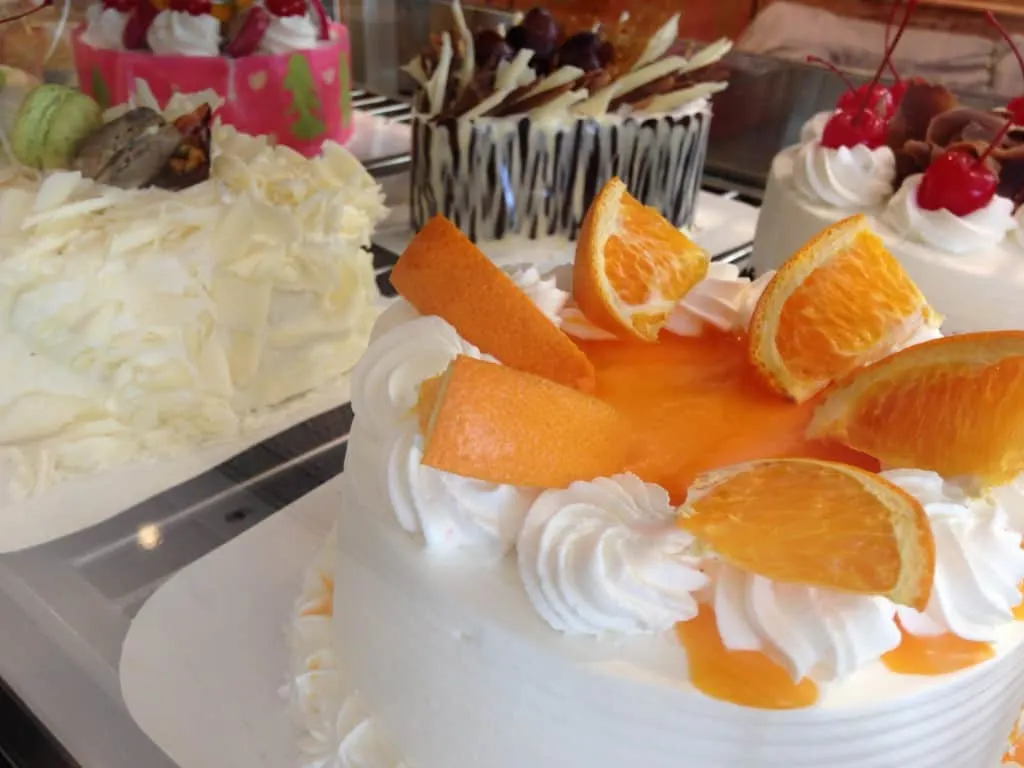
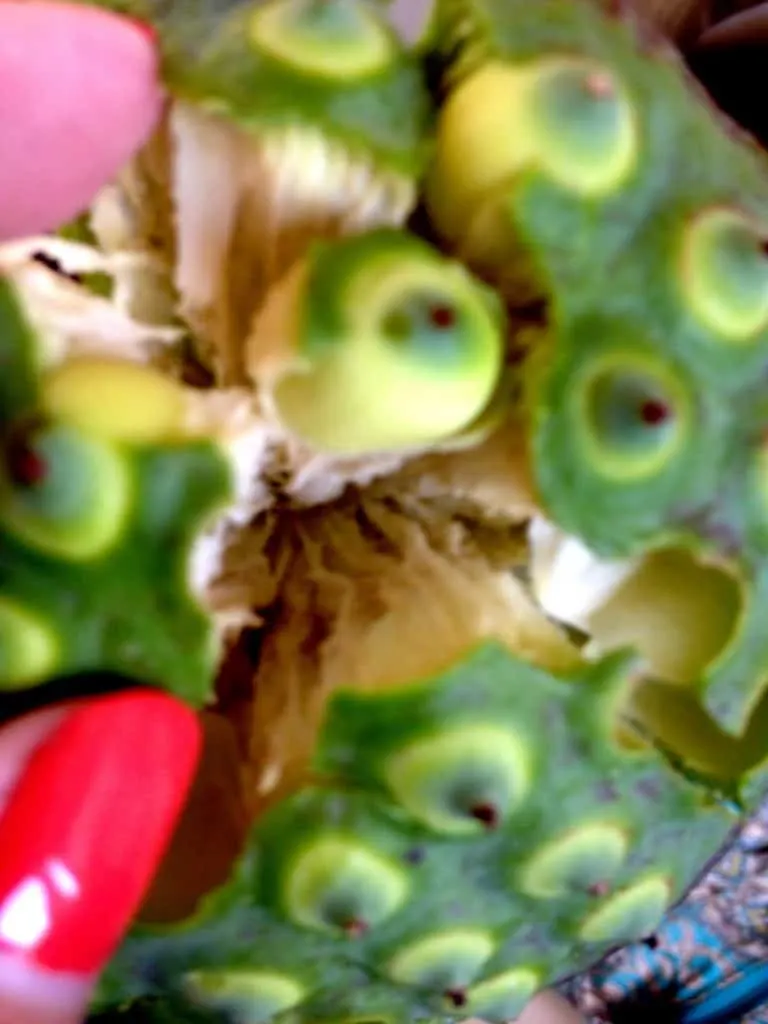

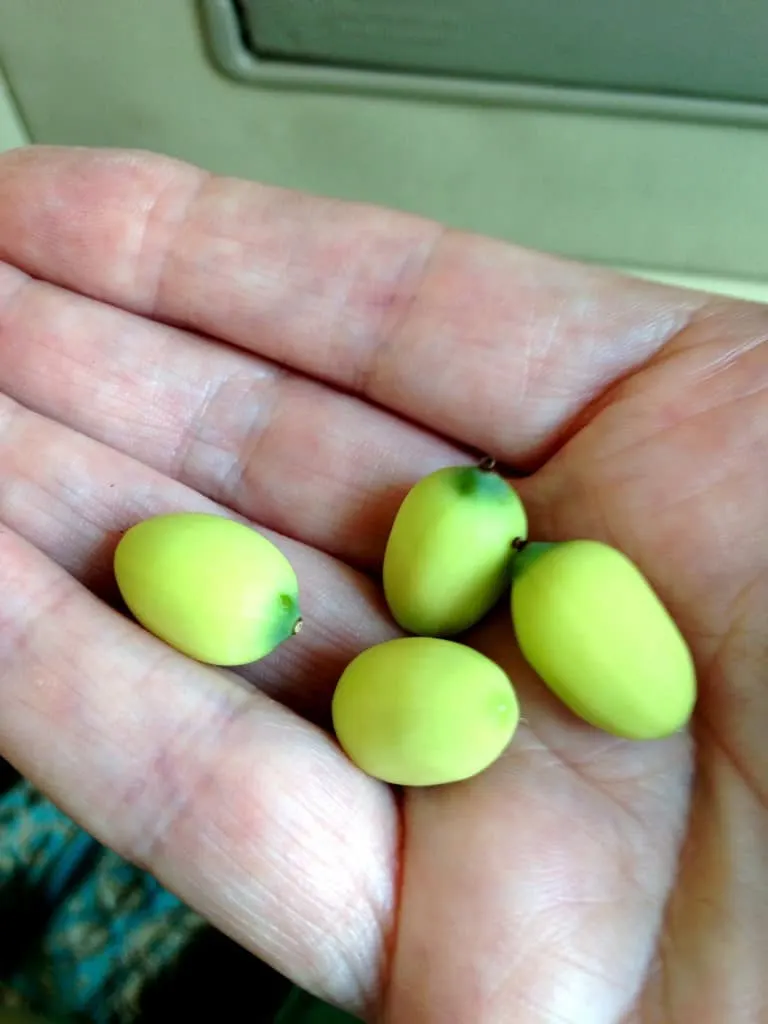

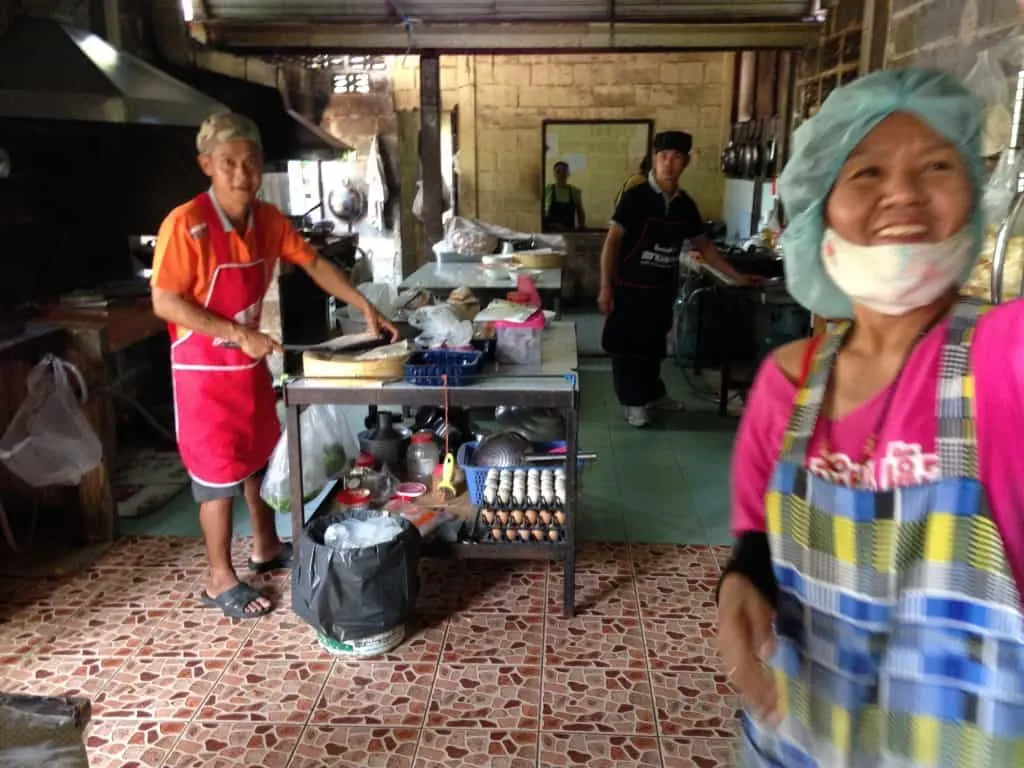
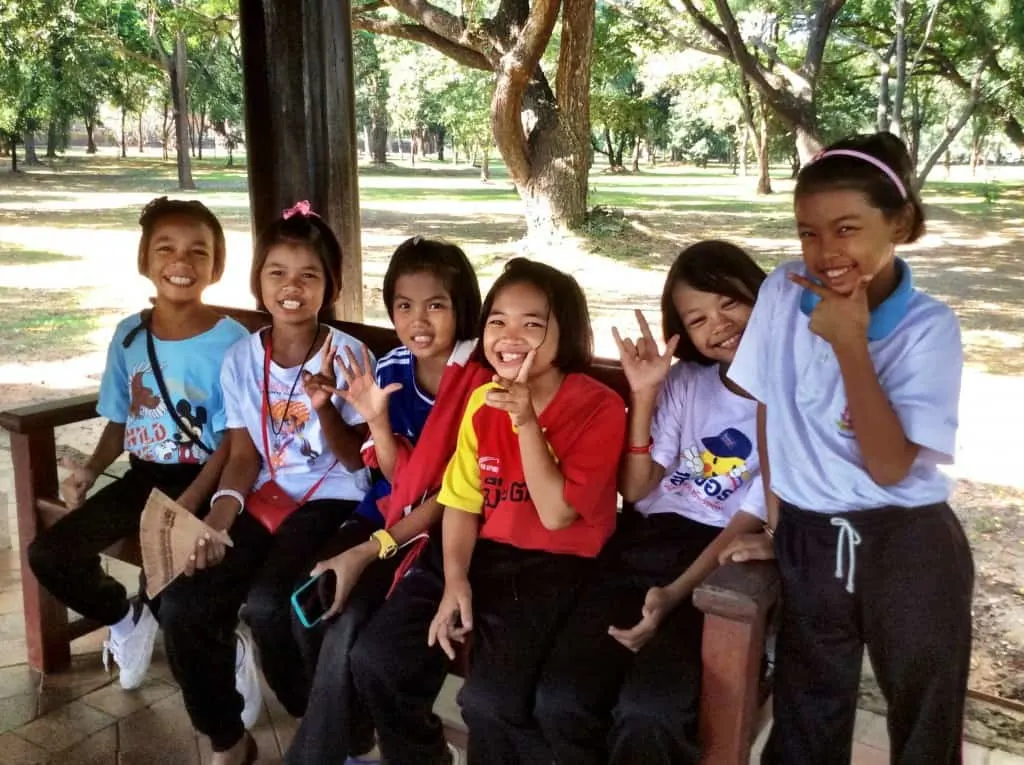
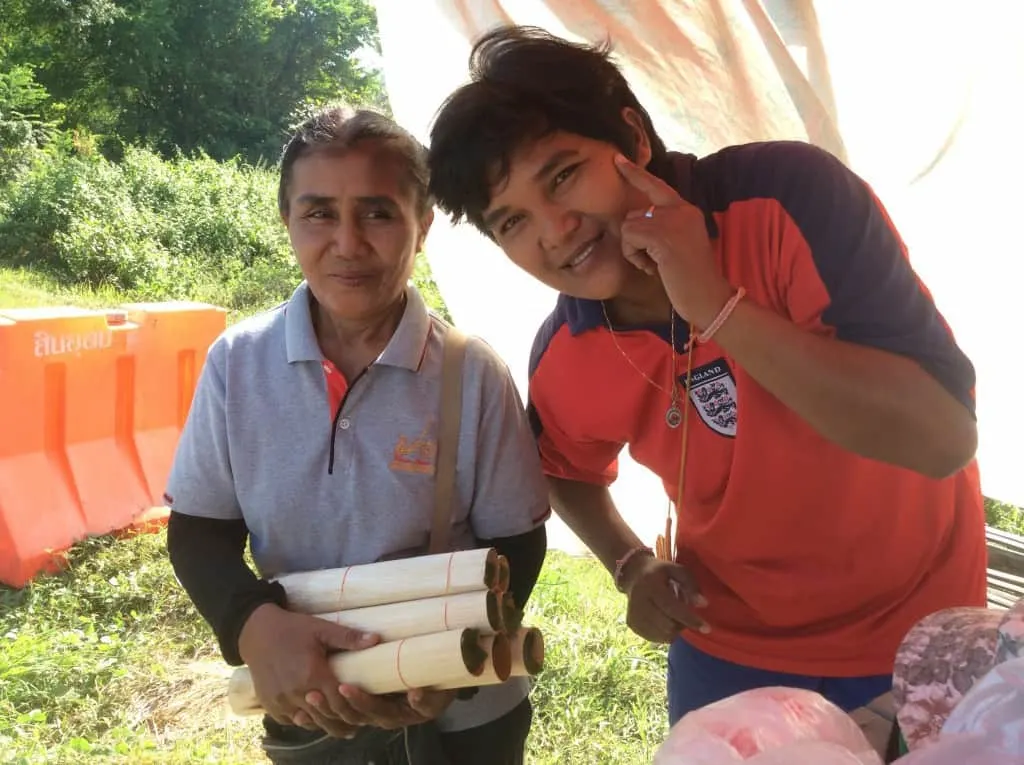
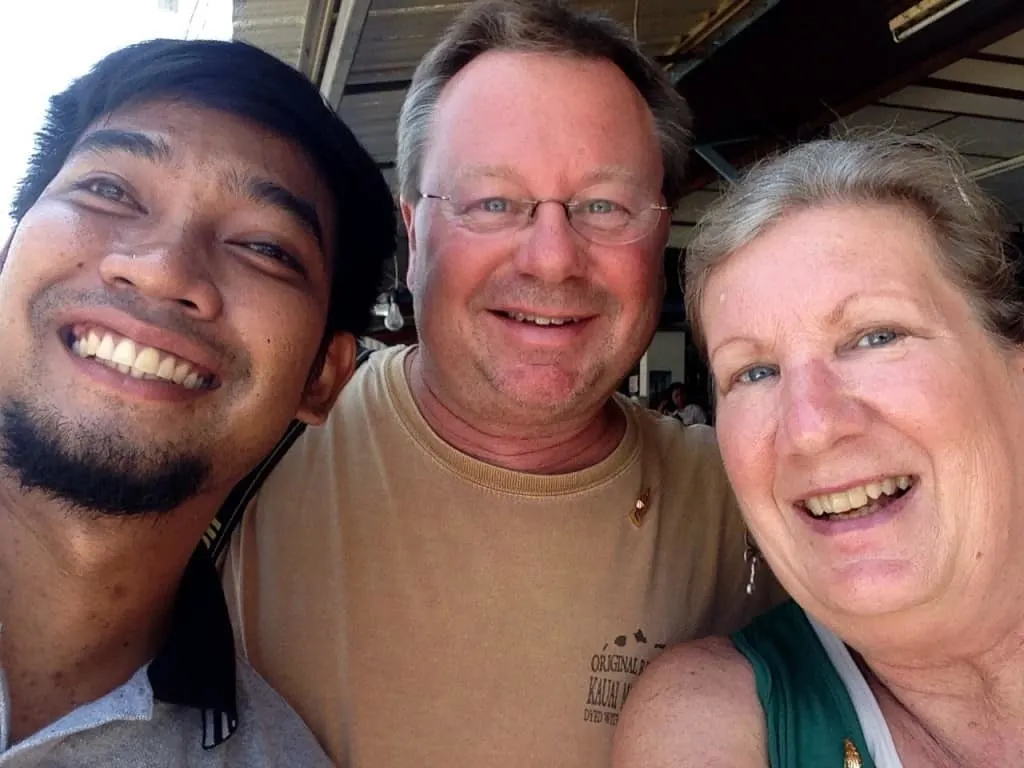
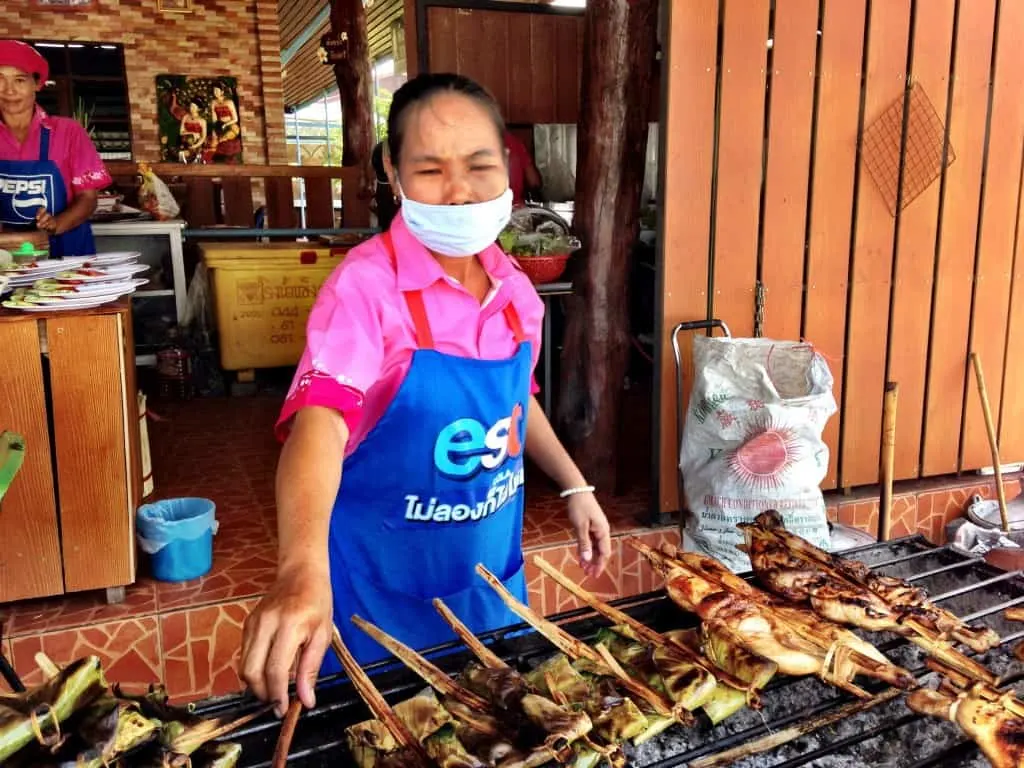
Andrew Comte
Friday 22nd of June 2018
Always great to find a post about Isaan. My wife is Isaan, and I love the region. Very much unrepresented part of Thailand.
Betsy Wuebker
Saturday 23rd of June 2018
Hi Andrew - Isaan would probably be the first region in Thailand we'd choose to spend an extended period. We loved our entire experience, but Isaan rose to the top.
How a Bucket List Ruins Travel and 5 Things You Can Do About It | Passing Thru
Monday 18th of April 2016
[…] and I think Pete’s is similarly low. (4.5? Well, yeah, I’m counting Angkor Wat just because we saw an older Khmer temple complex about 30 miles from it in Isaan. We’re getting ahead of ourselves, though: we’re going […]
In the "Lost City" of Wiang Kum Kam - Passing Thru
Wednesday 27th of January 2016
[…] visited Isaan, Bangkok, the southern islands, and beach resorts, Northern Thailand was next. We were looking for […]
alison abbott
Sunday 24th of January 2016
I'm with Rachael and was turned off by all the "touristy" press I had read about Thailand. As I read more and more Boomer reports, it seems to hold a lot more attraction than I had previously thought. Maybe I was just seeing visits of the wrong demographic!? Thanks for putting the authentic experience of Isaan on my radar. Nothing like charming people in a great destination to pull you out of an early morning slump.
Betsy Wuebker
Monday 25th of January 2016
Hi Alison - yes, there are definitely many sides to visiting Thailand, or, if you choose to look at it in a different way, perhaps better to say there really is something that will appeal to everyone. I think you'd really enjoy it.
Anita
Saturday 23rd of January 2016
Thank you for the introducing the Isaan region. From pictures it reminds me more Cambodia than Thailand. Interesting.
Betsy Wuebker
Sunday 24th of January 2016
Hi Anita - Yes, the terrain and culture is definitely different in Isaan than the other parts of Thailand you may have visited.